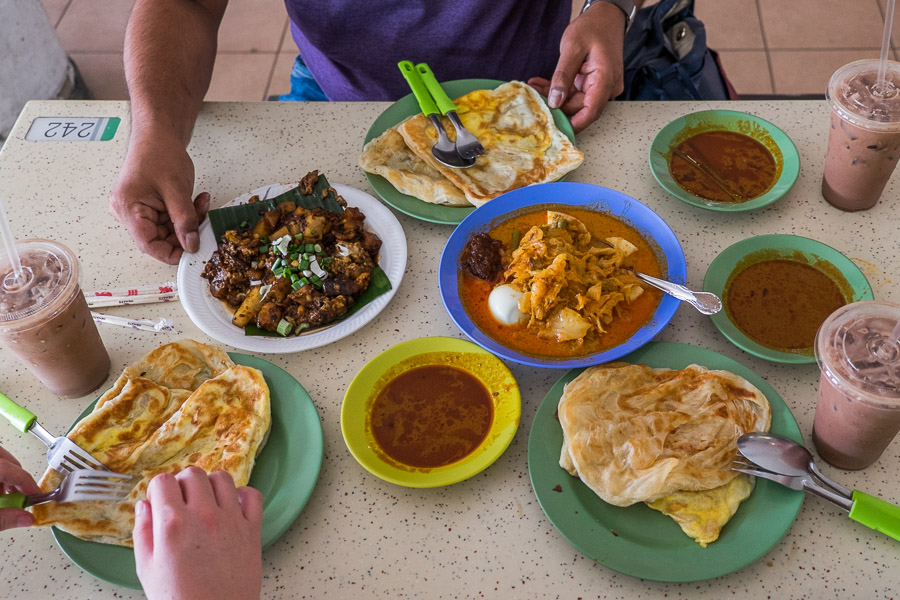Singapore 2016, Part 2
I was in Singapore from 15 to 19 July as a guest of Singapore Tourism Board. The timing of my visit was to coincide with the 2016 Singapore Food Festival and in my previous post I shared highlights from the festival. This post features other activities from our official itinerary.
Hotel Jen Orchardgateway
We stayed at Hotel Jen Orchardgateway, so named for Orchardgateway shopping mall right next door, which connects both sides of Orchard Road and provides convenient access to Somerset MRT station.
Singapore’s MRT train system
I’m a big fan of Singapore’s public train system, known as the MRT (Mass Rapid Transit), a great way to get around Singapore. The ‘EZ Link’ cards the locals use on public transport (like our Smartrider cards in Perth, Myki in Melbourne and Opal in Sydney) are available to tourists, but if you’re planning to get around quite a bit on public transport, the Singapore Tourist Pass may offer better value as it will give you access to unlimited public bus and train travel for 1, 2 or 3 days.The train system is being expanded and by 2030 it is planned that eight in 10 households will be within 10 minutes of a train station – an impressive statistic.
I had a Superior Room on the 6th floor. It was on the small side but perfect for a solo traveller – free wifi (and throughout the hotel), plenty of easily accessible power-points, small bar fridge, coffee/tea-making facilities and a flat screen TV I could watch from the comfortable king-sized bed. The wifi was fast enough that I was able to chat with Jac back home via FaceTime on my iPad a couple of times during my stay.
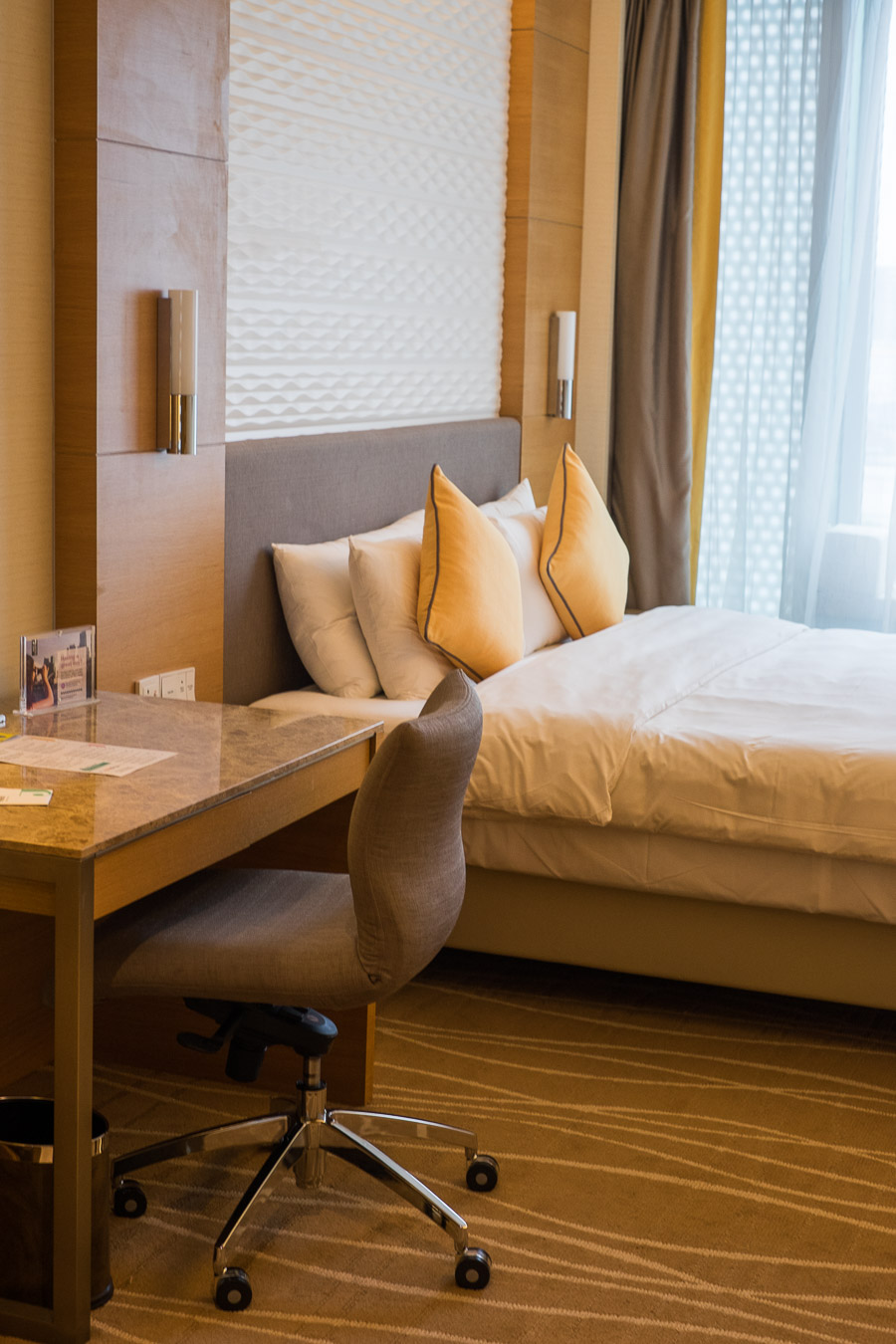
Power plugs in Singapore
Singapore outlets take the same three-pronged plug as used in the UK, Malaysia and Hong Kong – Type G. I usually bring an Australian powerboard (so I can plug in my camera charger and my multiple mobile devices all at the same time if required) and plug that into my Australian (Type I) to my international travel adaptor, which I plug into the wall outlet.
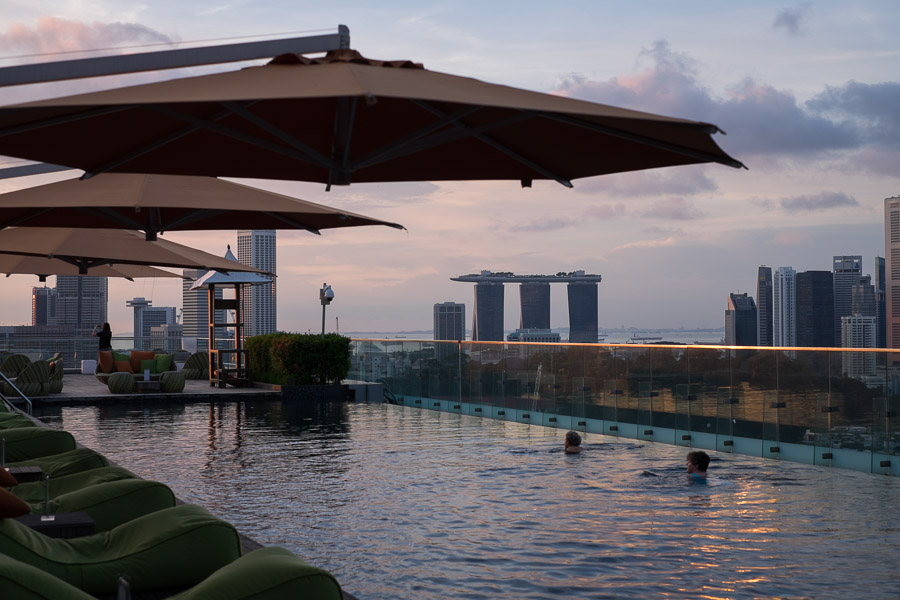 The infinity pool and poolside bar Baywatch @ Jen are on the rooftop where you can take in spectacular views of the city.
The infinity pool and poolside bar Baywatch @ Jen are on the rooftop where you can take in spectacular views of the city. 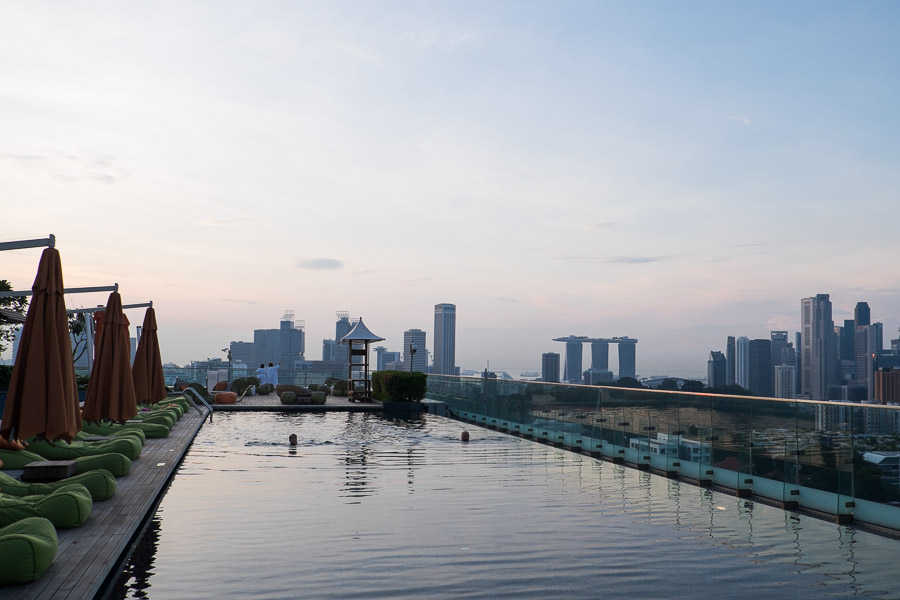 The pool is open from 6am to 11pm daily.
The pool is open from 6am to 11pm daily. 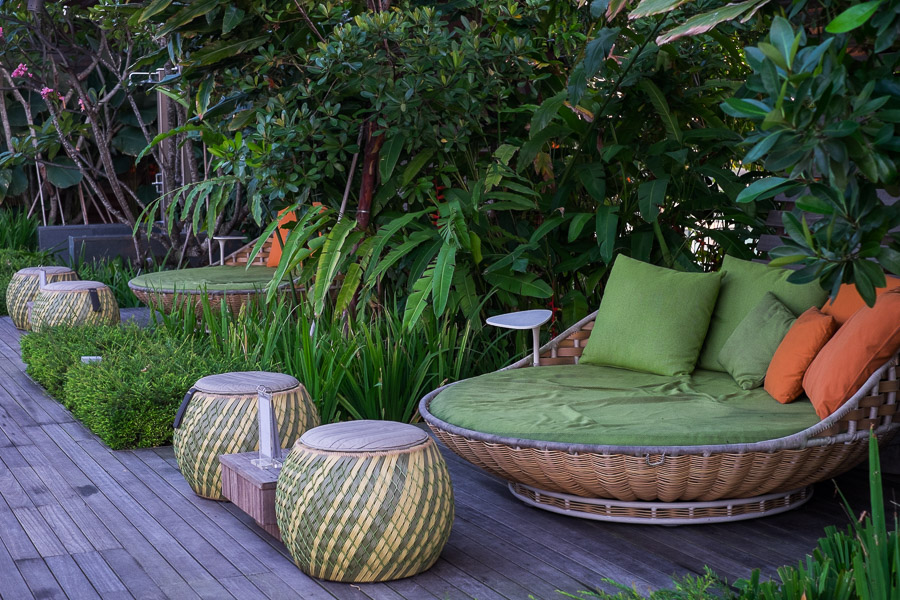
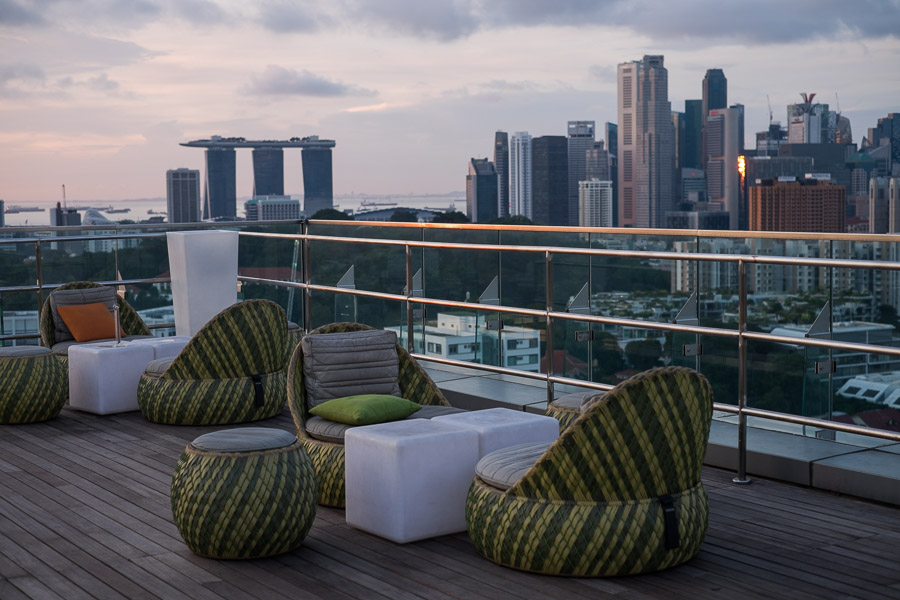 The pool bar is open from 11am to 11pm and if there had been more time, I’d have been quite happy relaxing poolside with a mocktail at sunset. In the evening, it’s a great vantage point for the Marina Bay Sands laser light show.
The pool bar is open from 11am to 11pm and if there had been more time, I’d have been quite happy relaxing poolside with a mocktail at sunset. In the evening, it’s a great vantage point for the Marina Bay Sands laser light show. 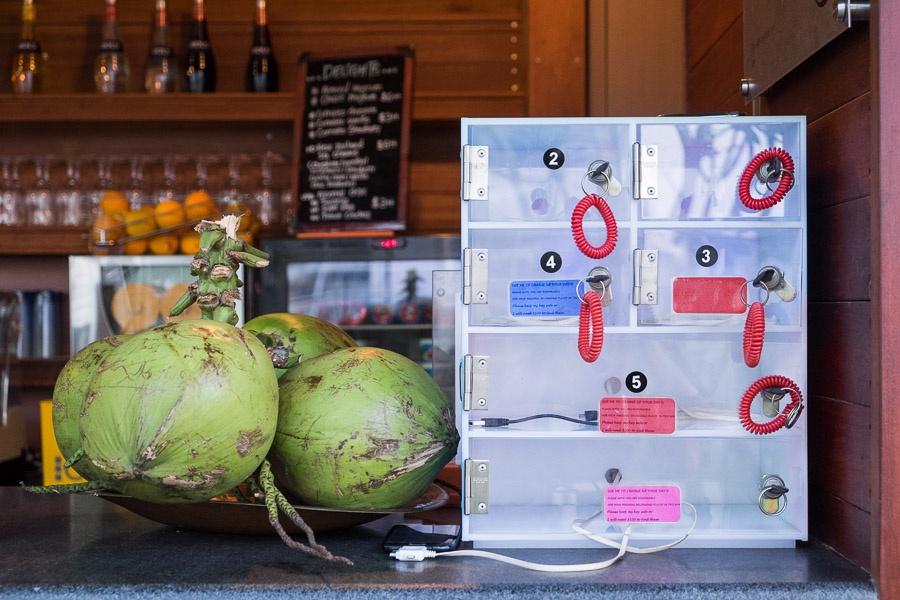 There are phone charging stations at strategic points around the hotel – reception, next to the hotel restaurant Makan @ Jen, and at the pool bar (pictured here).
There are phone charging stations at strategic points around the hotel – reception, next to the hotel restaurant Makan @ Jen, and at the pool bar (pictured here).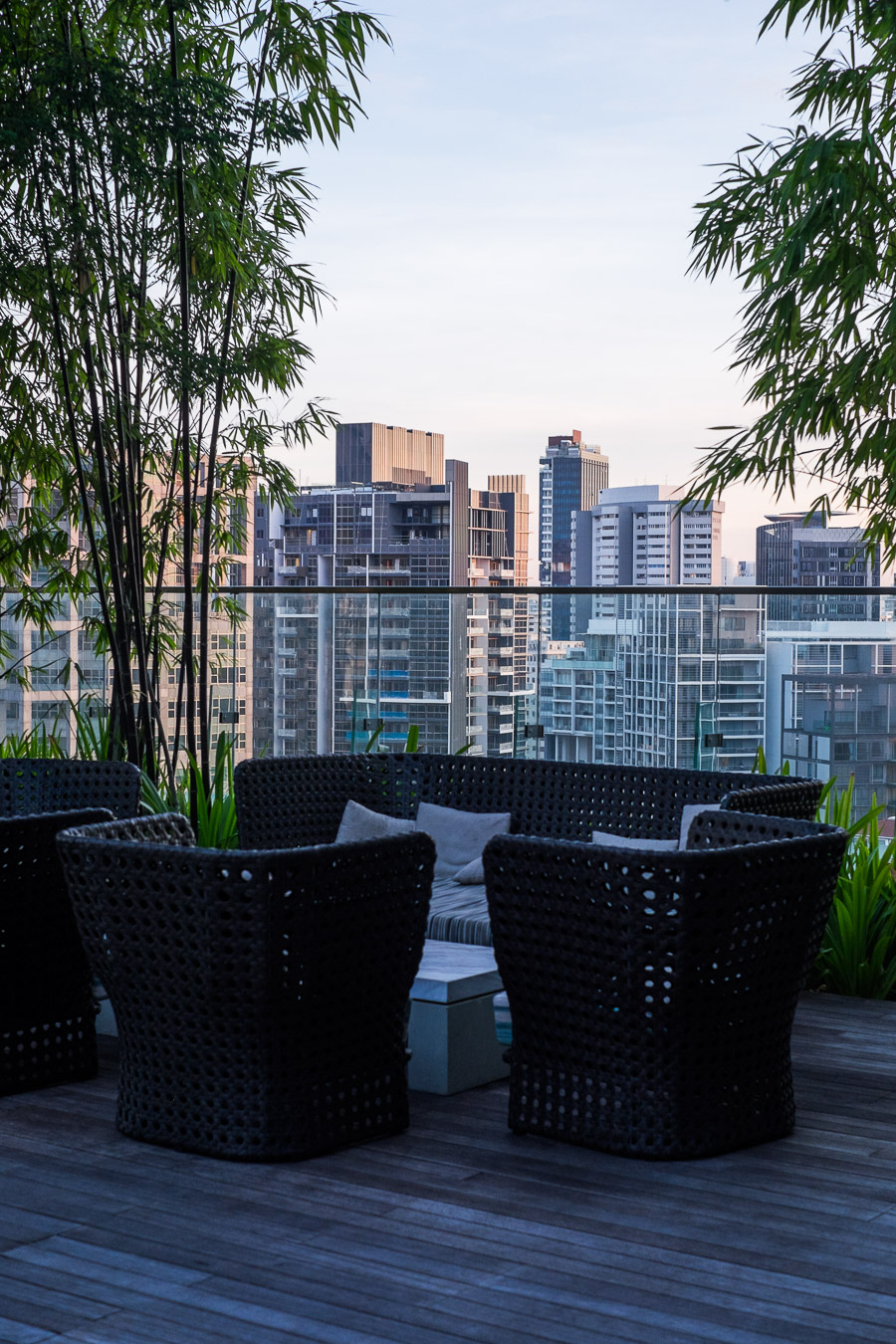 The hotel’s Zen Garden provides an outdoor space for events and meetings. The hotel gym is next door, open 24 hours. As you have guessed by the lighting in these photos, I took my photos very early in the morning when it was quiet.
The hotel’s Zen Garden provides an outdoor space for events and meetings. The hotel gym is next door, open 24 hours. As you have guessed by the lighting in these photos, I took my photos very early in the morning when it was quiet. Breakfast was included as part of my hotel stay, but with a jam-packed itinerary and tempting options a short walk away, I ate only once in the hotel’s restaurant, Makan @ Jen. Had my stay been longer, I’d have squeezed in at least a lunch or dinner at the restaurant as well.
As far as hotel breakfast buffets go, it was pretty good, with a decent selection of western and Asian dishes to cater to all tastes – with the customary egg station cooking eggs to order, bacon, tomatoes, hash browns, a baked ham, french toast and waffles, cereals, fresh fruit, yoghurt, cold meats and smoked salmon, cheeses, fried noodles, congee, nasi lemak with all the usual trimmings, and a noodle soup station. There was even a self-serve ice cream station – even though it was well before half-past 8am I couldn’t resist a scoop each of my two favourite flavours, durian and sweet corn. Great way to start the day!
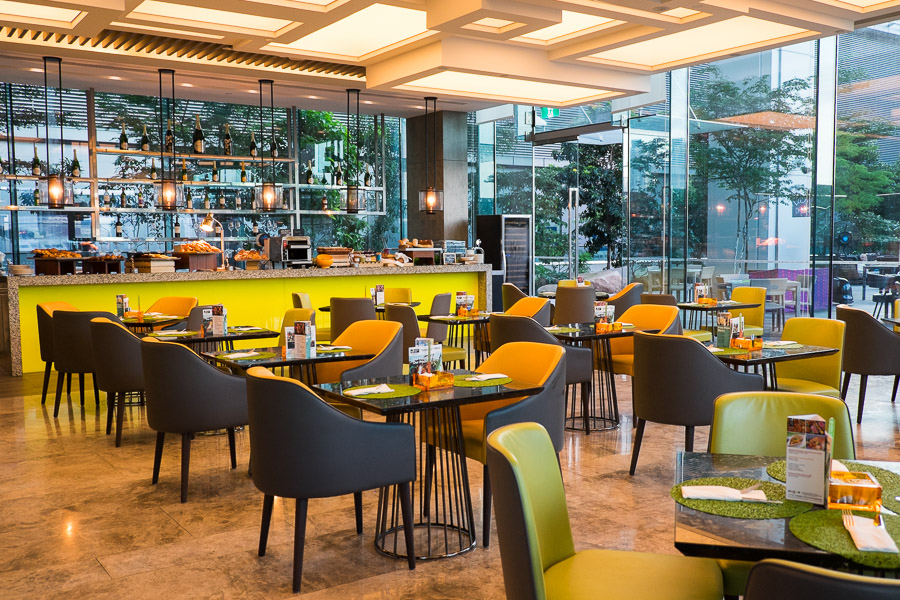 Makan @ Jen – ‘makan’ is Malay for ‘eat’.
Makan @ Jen – ‘makan’ is Malay for ‘eat’. 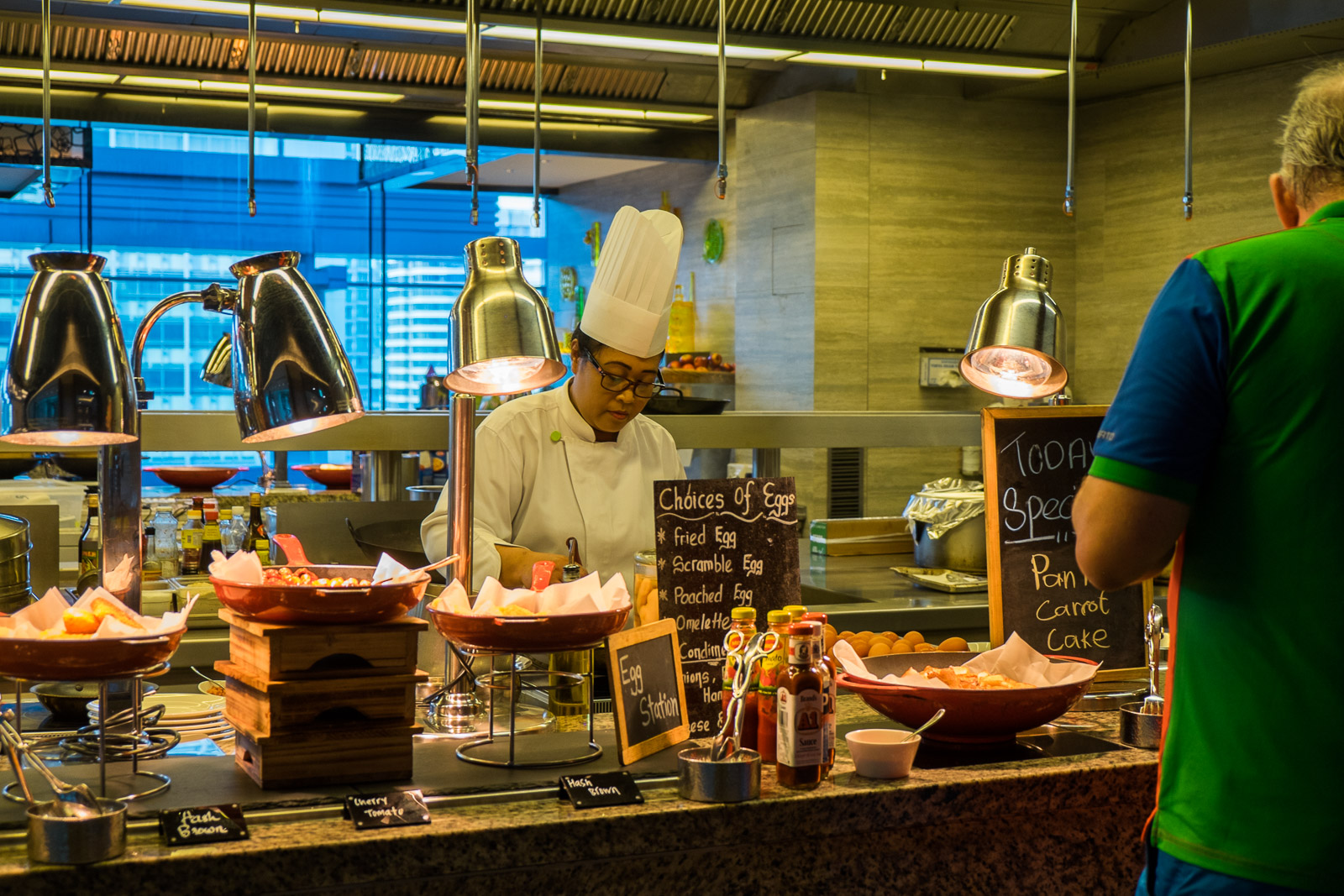 Breakfast buffet egg station
Breakfast buffet egg station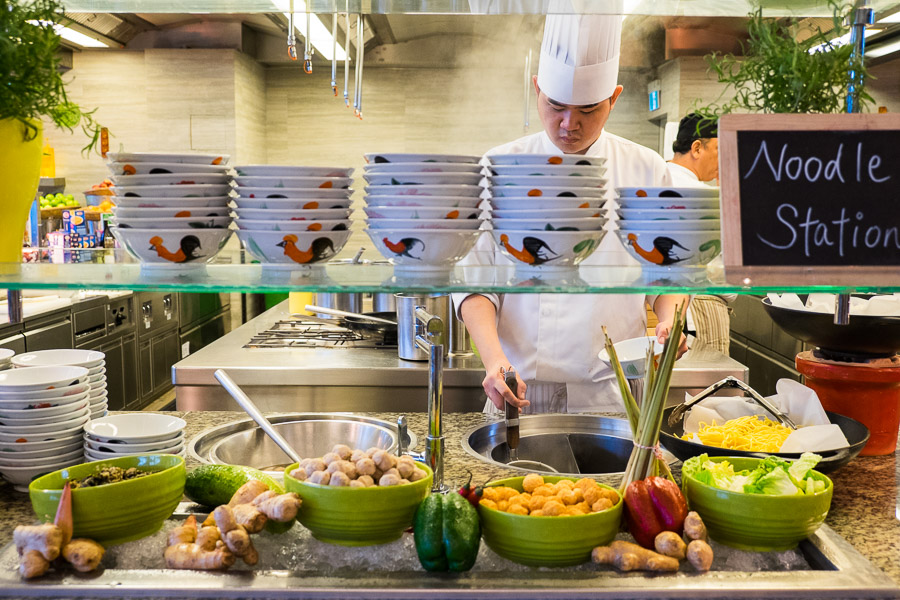 Noodle station – pick your noodles (rice, egg or both); fish balls, pork balls or both; Chinese cabbage.
Noodle station – pick your noodles (rice, egg or both); fish balls, pork balls or both; Chinese cabbage. 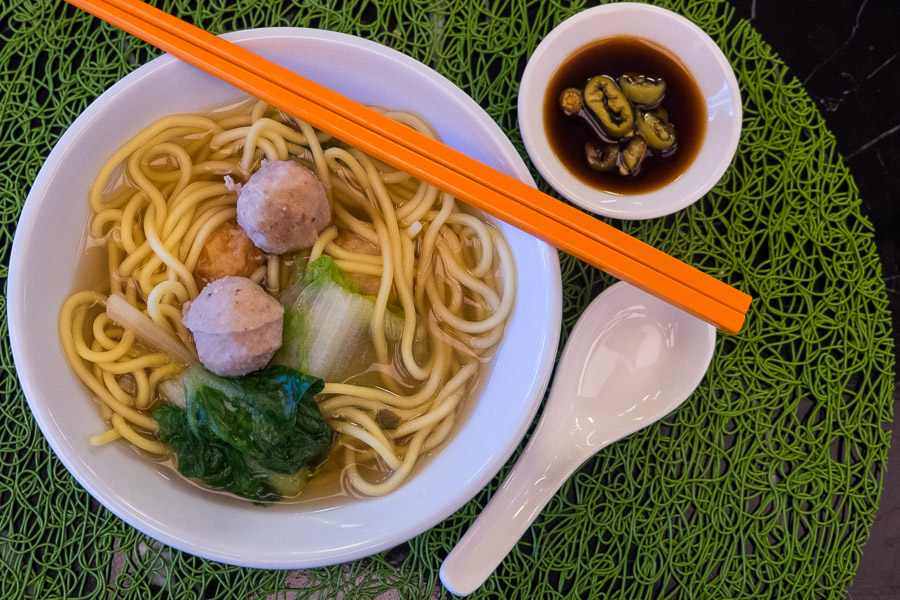 Although there was congee available at the buffet, I had my eye on congee at a nearby shophouse for another morning; so on this occasion, I had noodle soup instead, with chopped green chilli on the side. I had a taste of the nasi lemak too, just a taste (and then my two scoops of ice cream). I could’ve easily eaten more, and there was a panfried carrot cake breakfast special that morning too – but with a big day of eating ahead of me, some restraint was required.
Although there was congee available at the buffet, I had my eye on congee at a nearby shophouse for another morning; so on this occasion, I had noodle soup instead, with chopped green chilli on the side. I had a taste of the nasi lemak too, just a taste (and then my two scoops of ice cream). I could’ve easily eaten more, and there was a panfried carrot cake breakfast special that morning too – but with a big day of eating ahead of me, some restraint was required. - 277 Orchard Road, 238858, Singapore
- Around 25 minutes by car from Changi Airport
- Check-in 2pm, check-out 12pm
- Free wifi throughout the hotel, 24-hour room service
- Hotel Jen is the Shangri-La Group’s mid-range brand (previously branded as Traders Hotel)
- There are two Hotel Jens in Singapore; the other is Hotel Jen Tanglin
TWG Tea
My first meal after arriving in Singapore was at the splendid surroundings of TWG Tea Garden at Marina Bay Sands, a fantastic upgrade from airline food (although I quite liked the spicy chicken and mushroom noodles I was served for breakfast on my Singapore Airlines flight).
‘TWG’ stands for The Wellbeing Group, established in Singapore in 2008. TWG Tea offers a mind-boggling selection of over 800 different teas but its Salons won’t just delight tea connoisseurs – food lovers will find plenty to like here. When I come to Singapore I want to eat mostly at shophouses, hawker centres and food courts; but when I hit the point craving more western-style fare – TWG Tea may well come to the rescue.
The savoury dishes served at TWG Tea all incorporate its signature teas in some way and you can order hot or iced teas or tea cocktails and mocktails to match. I chose the Tokyo-Singapore tea, a light, green tea with citrus notes, served hot. We didn’t have room to try any of the handmade tea-infused ice cream/sorbet – that’s on my list for next time.
- We dined at TWG Tea Garden at Marina Bay Sands, which is one of two TWG Tea Salons at Marina Bay Sands – the other is TWG Tea on the Bridge.
- Prices have been included for your information and do not include service charge or GST.
- There are ten TWG Tea locations in Singapore (including four at Changi Airport) plus TWG Tea locations around the world.
- In Australia, TWG Tea products are available at David Jones (Sydney, Adelaide, Melbourne and Perth).
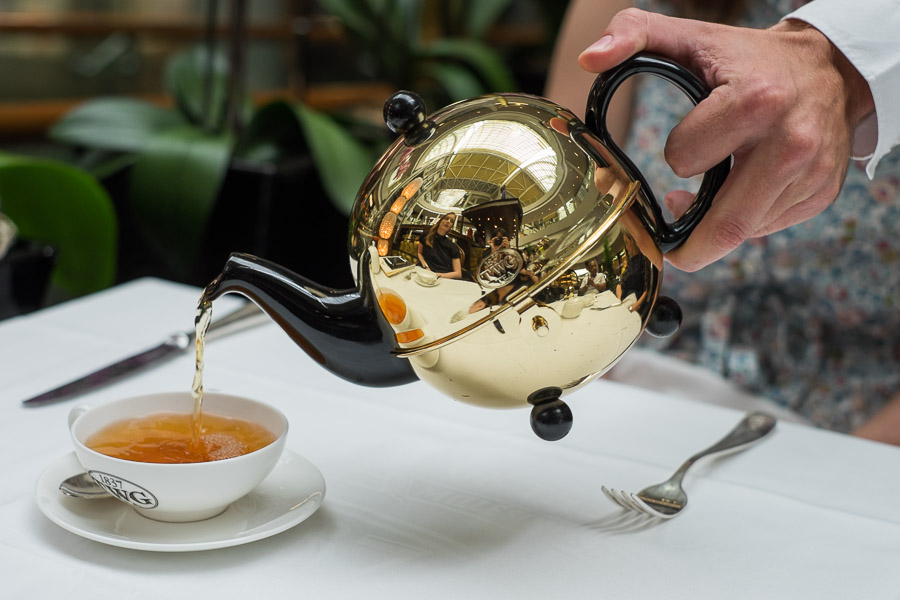
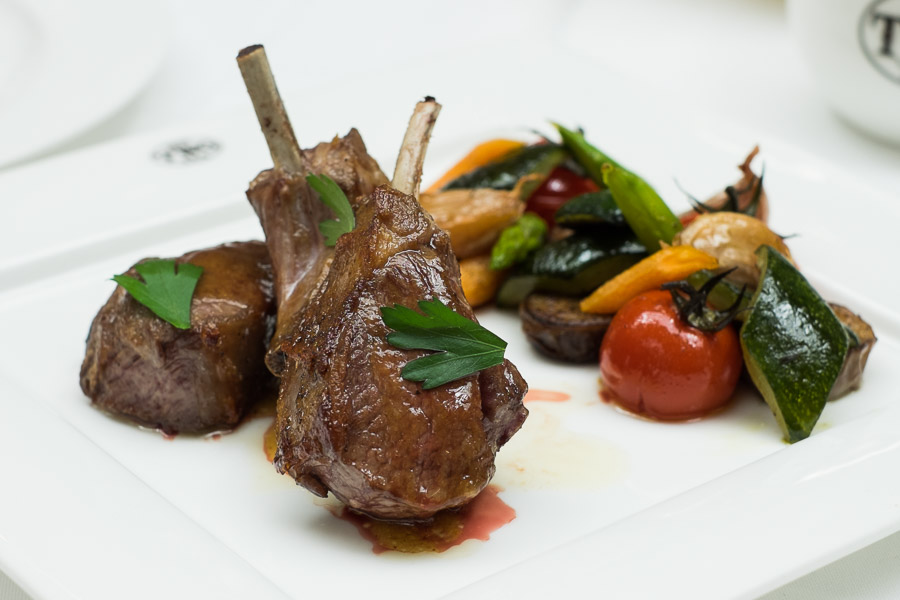 New Zealand lamb rack (SG$28) with tomatoes, zucchini and an eggplant medley infused with Number 13 Tea, served with silky potato mash and a natural jus. The lamb and vegetables were well seasoned and cooked beautifully.
New Zealand lamb rack (SG$28) with tomatoes, zucchini and an eggplant medley infused with Number 13 Tea, served with silky potato mash and a natural jus. The lamb and vegetables were well seasoned and cooked beautifully. 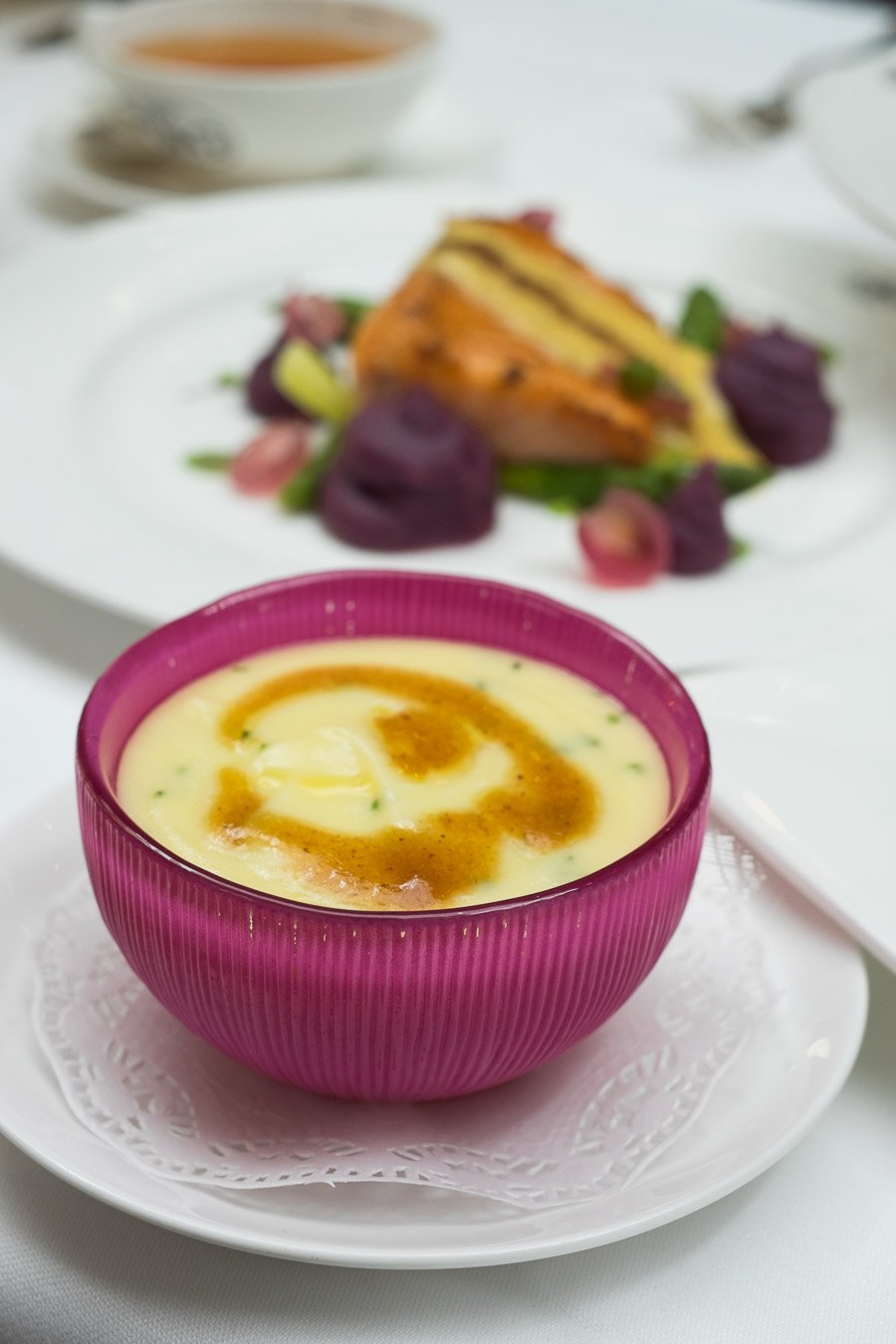 The potato mash (served with the lamb rack) was buttery and dangerously moreish.
The potato mash (served with the lamb rack) was buttery and dangerously moreish. 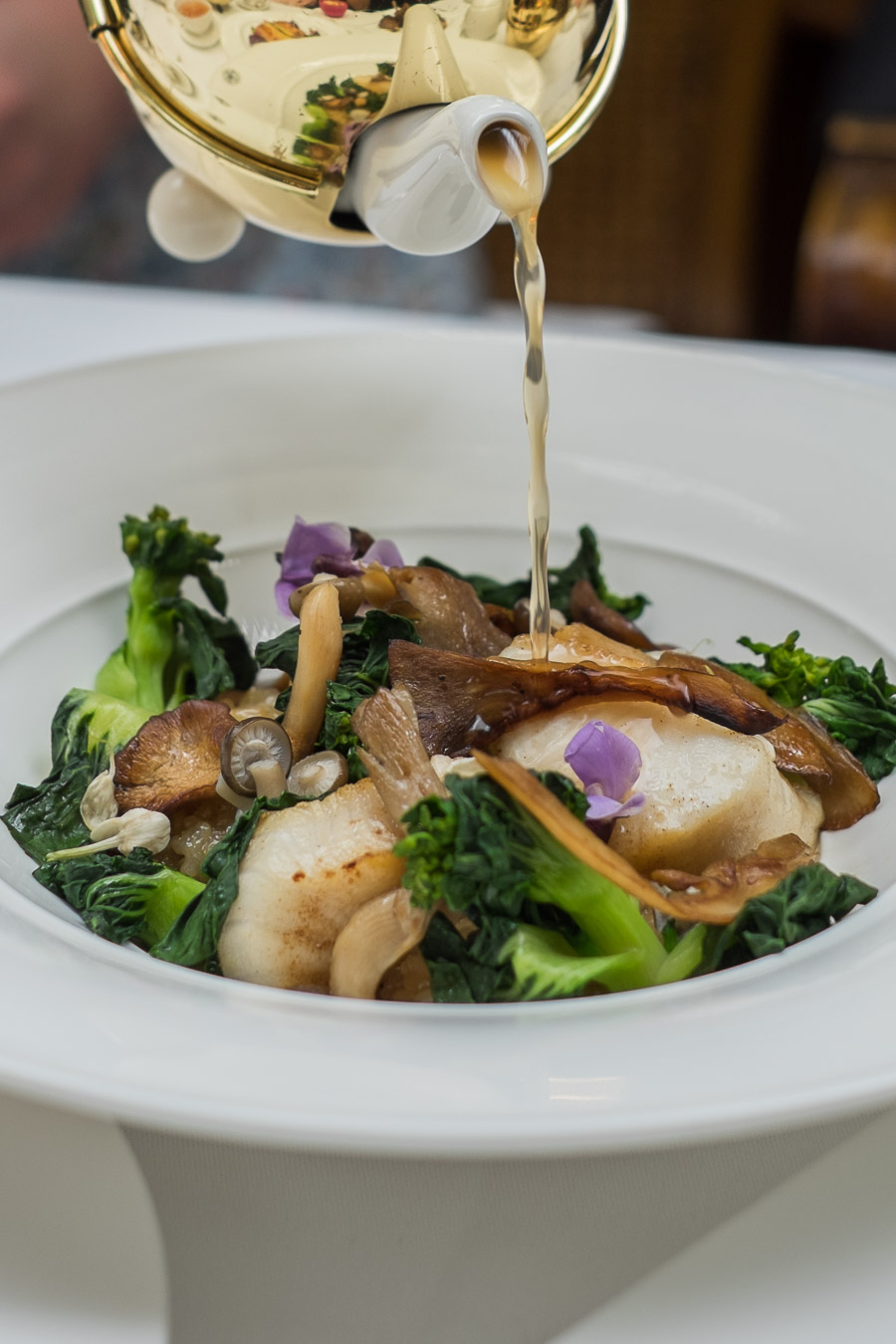 My favourite of the dishes – pan-roasted black cod (SG$28) with steamed baby bok choy, shimeji and oyster mushrooms, and garlic Korean brown rice underneath like a cross between risotto and congee (absolutely delicious!). Dashi broth infused with Meleng FBOP and French Earl Grey was poured over the dish at the table.
My favourite of the dishes – pan-roasted black cod (SG$28) with steamed baby bok choy, shimeji and oyster mushrooms, and garlic Korean brown rice underneath like a cross between risotto and congee (absolutely delicious!). Dashi broth infused with Meleng FBOP and French Earl Grey was poured over the dish at the table.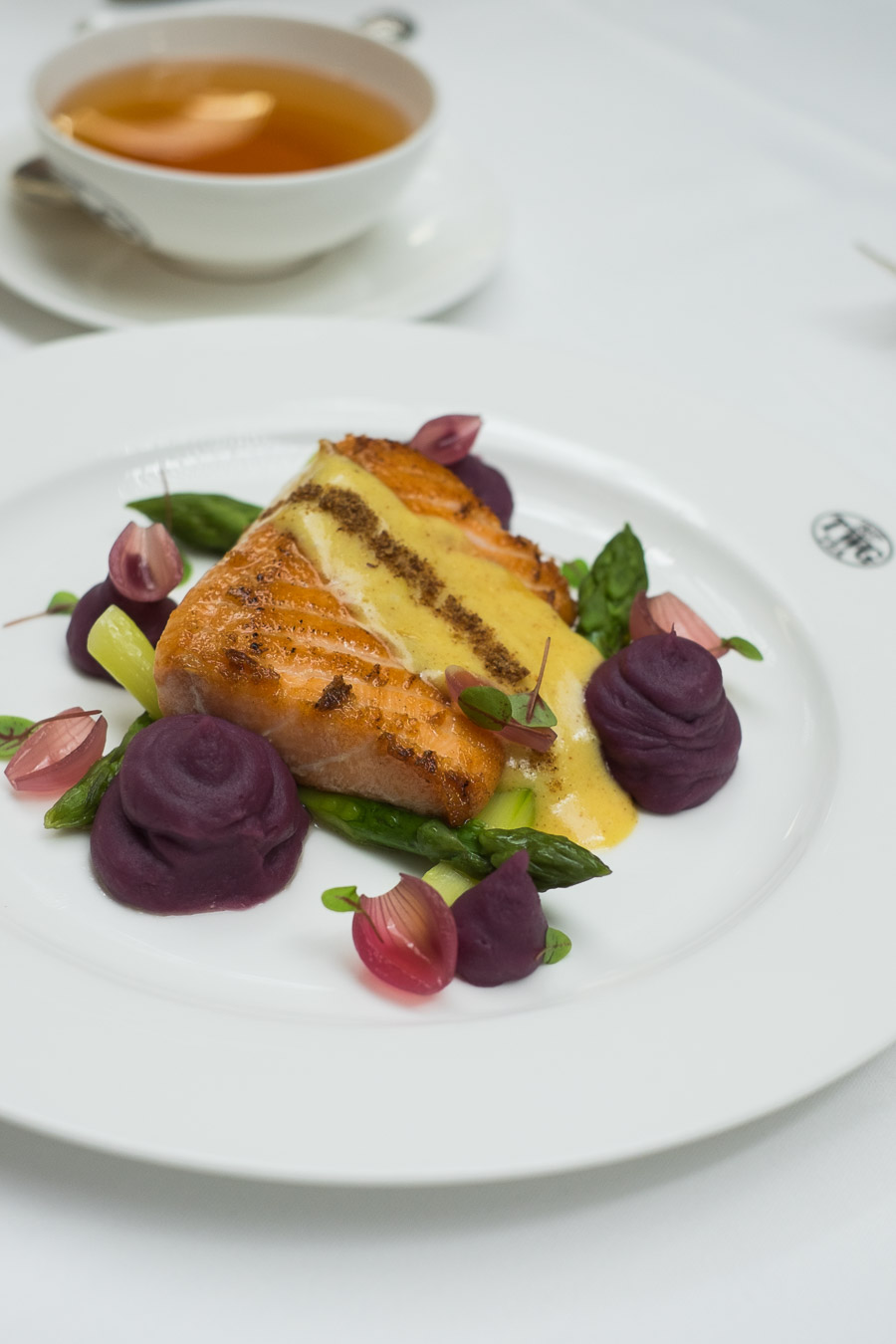 Lightly seared Norwegian salmon confit (SG$28) in Vanilla Tea infused oil served with Japanese sweet potato puree and asparagus, accompanied by pickles and a hazelnut butter hollandaise sauce. There was a lot going on on this colourful plate (and I initially regarded that purple sweet potato with suspicion) but the end result was surprisingly harmonious. The salmon, cod and lamb dishes are all on the all-day dining menu, available from 11.30am.
Lightly seared Norwegian salmon confit (SG$28) in Vanilla Tea infused oil served with Japanese sweet potato puree and asparagus, accompanied by pickles and a hazelnut butter hollandaise sauce. There was a lot going on on this colourful plate (and I initially regarded that purple sweet potato with suspicion) but the end result was surprisingly harmonious. The salmon, cod and lamb dishes are all on the all-day dining menu, available from 11.30am. 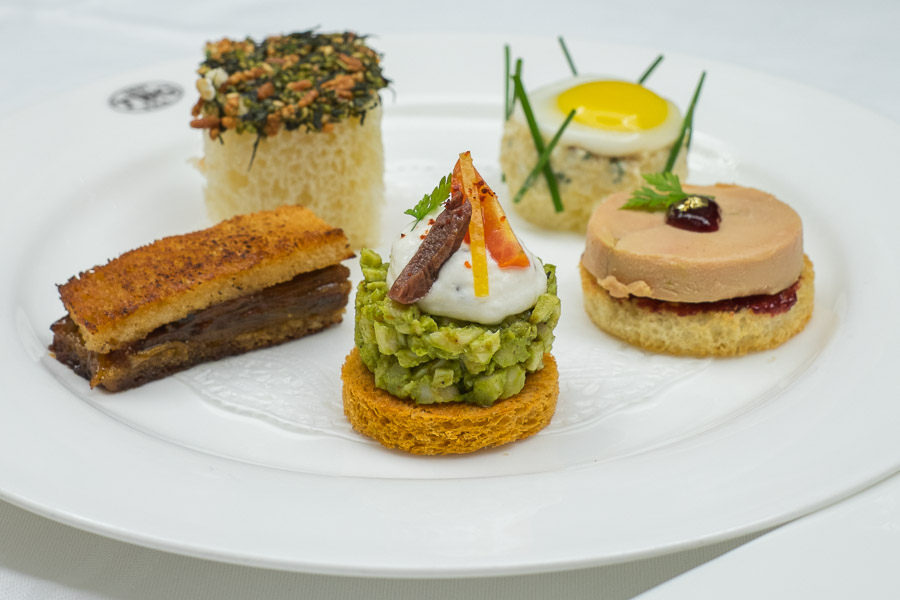 Gorgeous finger sandwiches (SG$24) from the Tea Time menu available from 2pm to 6pm: from the front, moving clockwise: smoky Russian tea infused tomato bread with pesto chicken and stracciatella cheese,; warm lamb and vegetable mille-feuille infused with Moroccan mint tea; smoked salmon and horseradish cream with nori and Genmaicha furikake; mimosa egg sandwich with aioli and mirror quail egg; and foie gras medallion with homemade Summer Palace Tea infused cherry jam. Where would you start?
Gorgeous finger sandwiches (SG$24) from the Tea Time menu available from 2pm to 6pm: from the front, moving clockwise: smoky Russian tea infused tomato bread with pesto chicken and stracciatella cheese,; warm lamb and vegetable mille-feuille infused with Moroccan mint tea; smoked salmon and horseradish cream with nori and Genmaicha furikake; mimosa egg sandwich with aioli and mirror quail egg; and foie gras medallion with homemade Summer Palace Tea infused cherry jam. Where would you start? 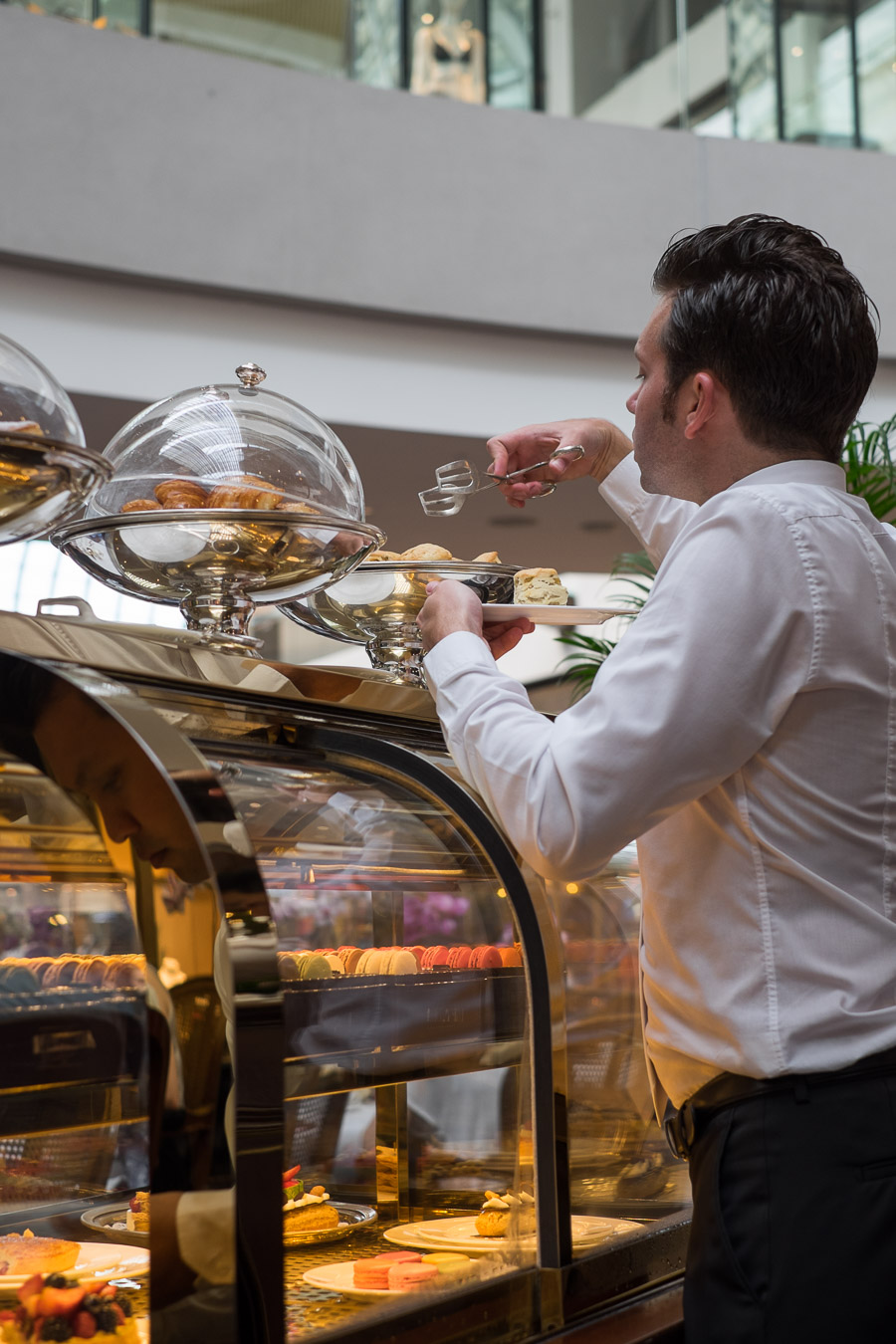
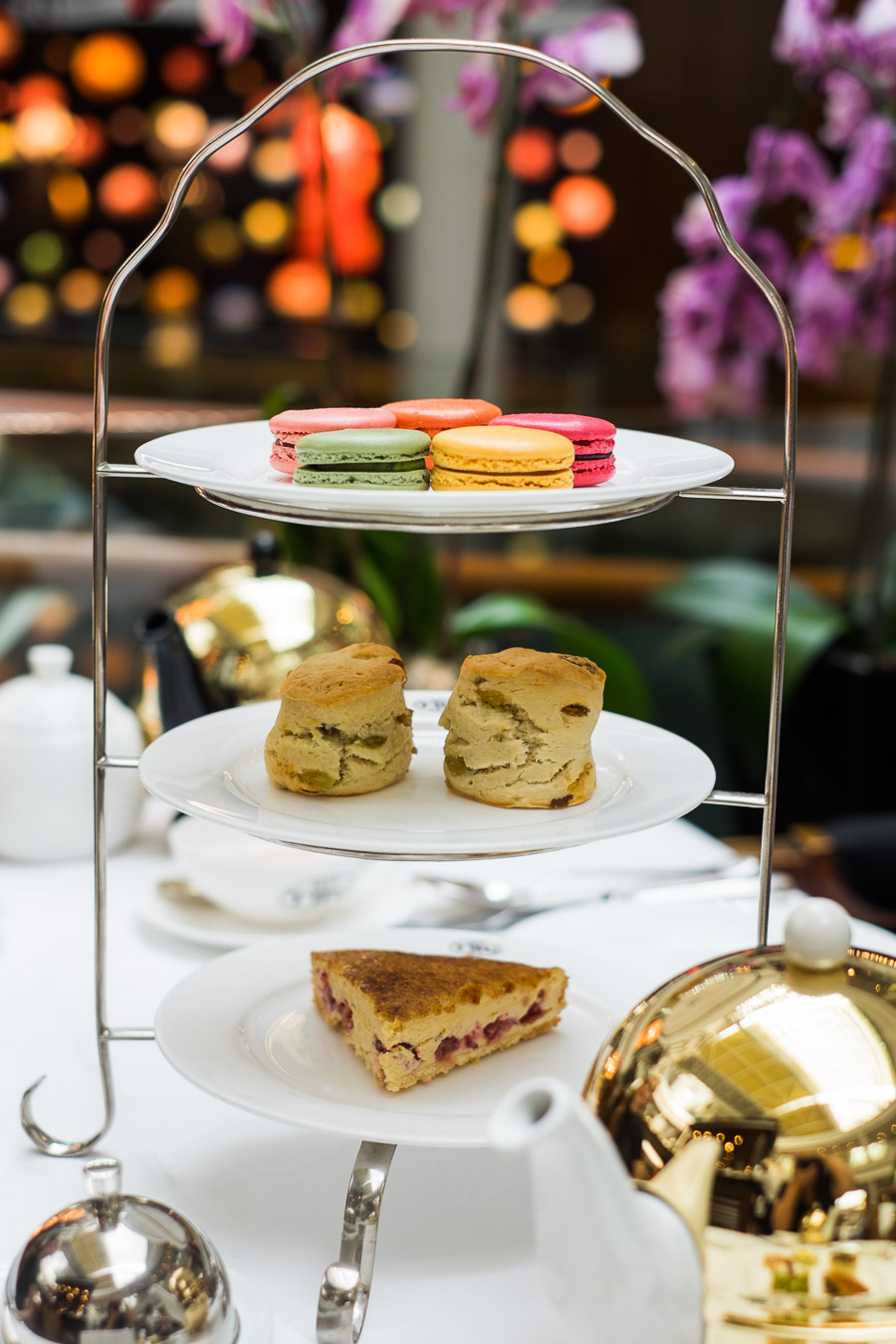 The macarons (SG$2 each) are infused with TWG signature teas with flavours including Lemon Bush tea, 1837 Black Tea and blackcurrant, Bain de Rose, and Matcha. The warm raisin scones were served with TWG Geisha Blossom Tea Jelly and whipped cream. My favourite here was TWG’s signature Singapore Surprise (on the bottom tier), a creme brulee tart filled with vanilla bourbon tea-infused cream and raspberries.
The macarons (SG$2 each) are infused with TWG signature teas with flavours including Lemon Bush tea, 1837 Black Tea and blackcurrant, Bain de Rose, and Matcha. The warm raisin scones were served with TWG Geisha Blossom Tea Jelly and whipped cream. My favourite here was TWG’s signature Singapore Surprise (on the bottom tier), a creme brulee tart filled with vanilla bourbon tea-infused cream and raspberries. 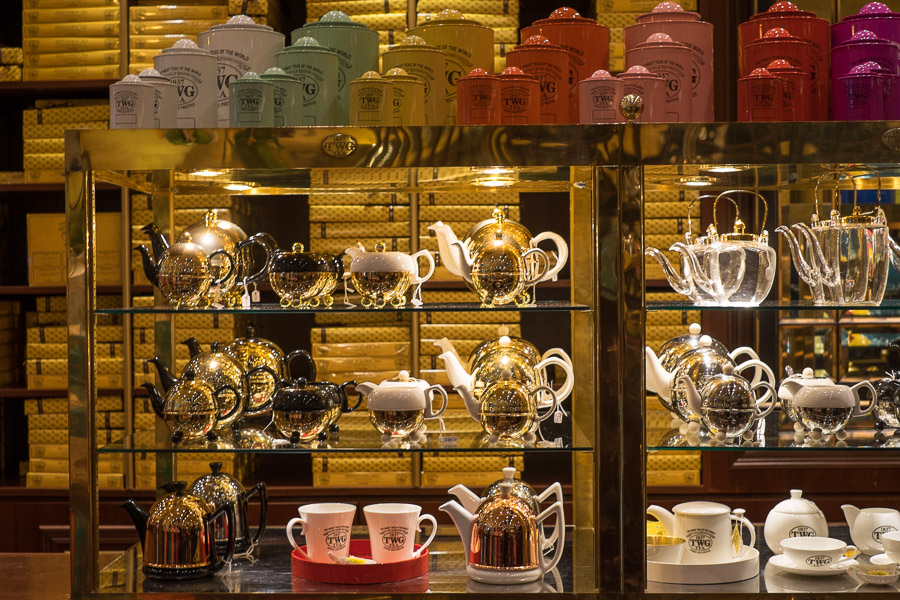 We had a quick look in a TWG Tea Boutique where you can buy TWG Tea products, including gift-boxed macarons, teas in colourful and whimsically illustrated tins, teapots and all manner of tea-related accessories.
We had a quick look in a TWG Tea Boutique where you can buy TWG Tea products, including gift-boxed macarons, teas in colourful and whimsically illustrated tins, teapots and all manner of tea-related accessories. 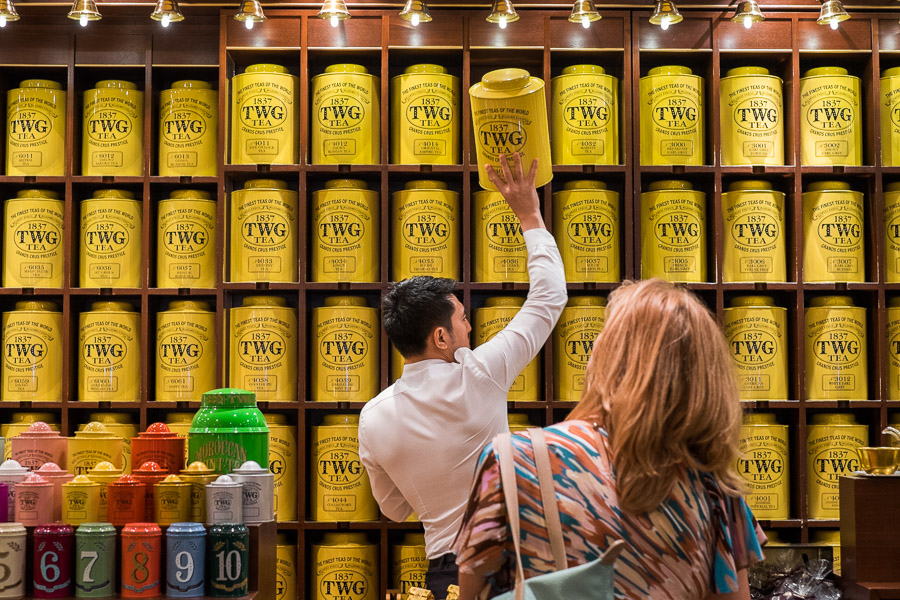 The signature tea wall was an impressive sight in the TWG Tea Boutique.
The signature tea wall was an impressive sight in the TWG Tea Boutique. 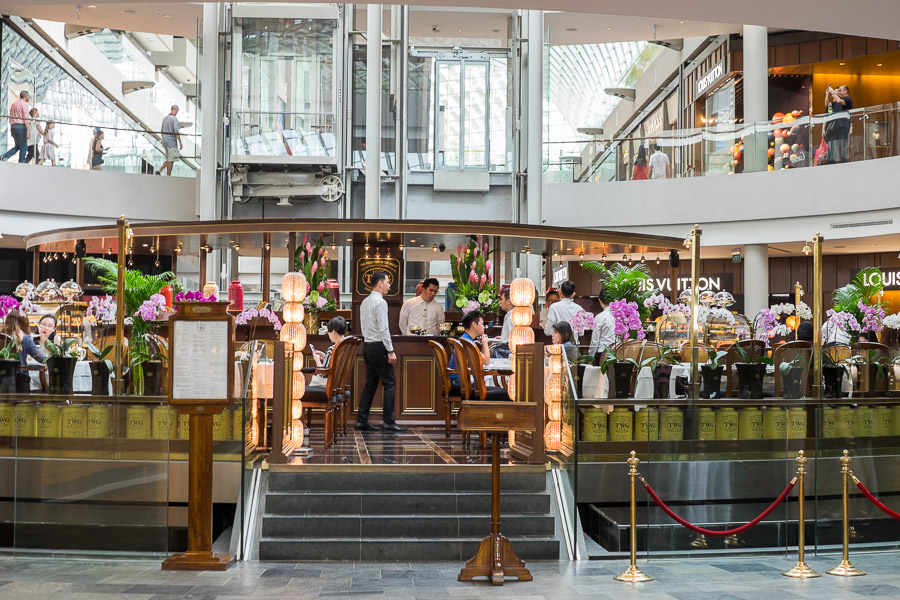 Entrance to TWG Tea Gardens at Marina Bay Sands.
Entrance to TWG Tea Gardens at Marina Bay Sands. Service charge in Singapore
Restaurants in Singapore will add a mandatory additional 17% to your bill, comprising a 10% service charge and 7% Goods and Services Tax. Sometimes you will see prices displayed with ‘++’ (referred to by locals as “plus plus”) e.g. ‘$19.90++’ This indicates the 17% hasn’t been included in the displayed price but will be included in the final bill. Generally, the service charge will apply at restaurants where you get table service i.e. waiters take your order and bring the food out to you (you shouldn’t be charged service fee at a hawker centre, for example). Service charge and GST apply to retail stores and hotels too. Where prices are displayed with ‘NET’ or ‘NETT’, it means the taxes have been included. It is worth remembering about ‘++’ to avoid a rude shock when you get your bills – it may not send you broke, but unexpected charges are never nice.
Tiong Bahru Market and neighbourhood walk
There’s lots to like about Tiong Bahru – great hawker food, street art and art deco architecture – there are old-school coffee shops as well as cool cafes and bars, art galleries and boutique stores – our sweaty but enjoyable stroll through the neighbourhood was but a brief introduction. It’s a nice change of pace from the malls of Orchard Road. I plan to return and take more time to explore Tiong Bahru with Jac on our next trip to Singapore.
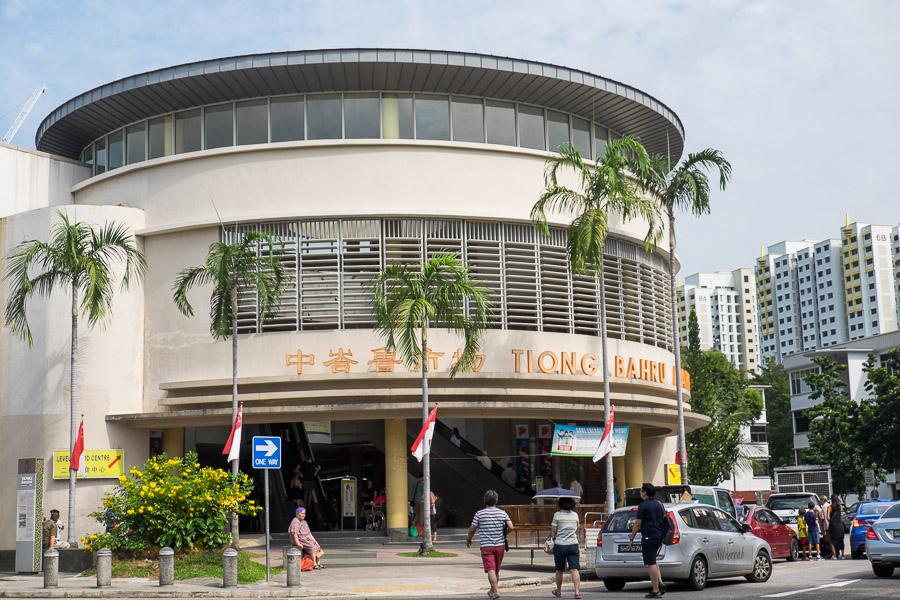 We had breakfast at the hawker centre upstairs at Tiong Bahru Market; the wet market is downstairs.
We had breakfast at the hawker centre upstairs at Tiong Bahru Market; the wet market is downstairs. 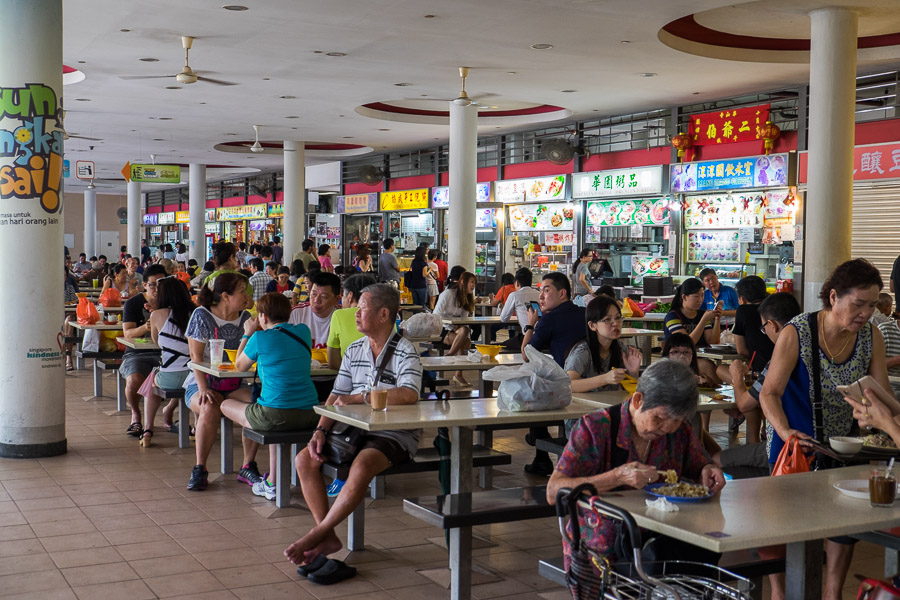
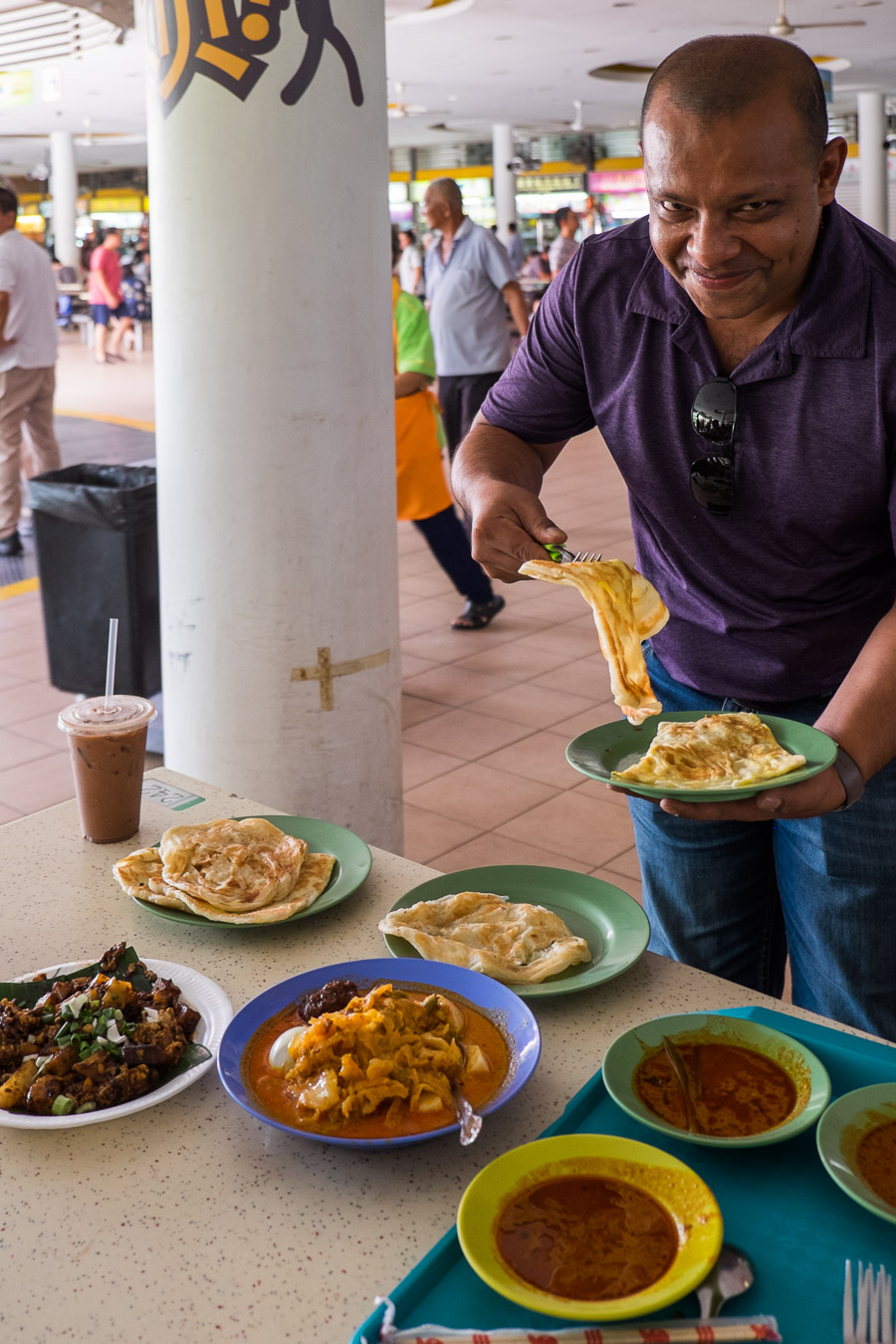 Our breakfast feast – prata (plain and with egg) with curry dipping sauce, dark carrot cake (chai tow kway), lontong sayur lodeh (compressed rice cake with vegetables, tofu and egg in curry) and ice Milo.
Our breakfast feast – prata (plain and with egg) with curry dipping sauce, dark carrot cake (chai tow kway), lontong sayur lodeh (compressed rice cake with vegetables, tofu and egg in curry) and ice Milo. 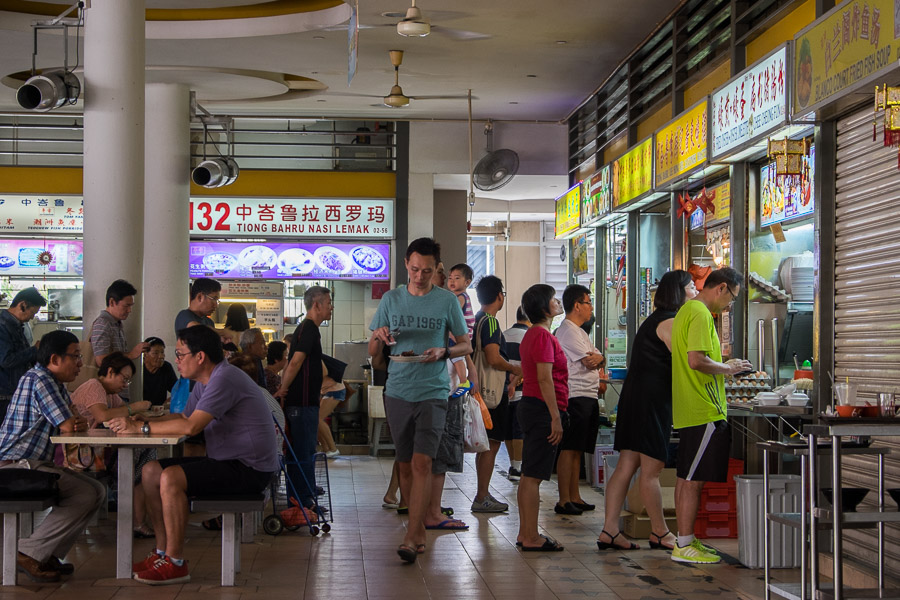 The hawker centre is massive. Gluttons and indecisive eaters (worse, indecisive gluttons) will have a tough time deciding what to have. Of course, if you lived here, you could just work your way around the entire place. Hawker centres are my favourite places to eat in Singapore.
The hawker centre is massive. Gluttons and indecisive eaters (worse, indecisive gluttons) will have a tough time deciding what to have. Of course, if you lived here, you could just work your way around the entire place. Hawker centres are my favourite places to eat in Singapore. 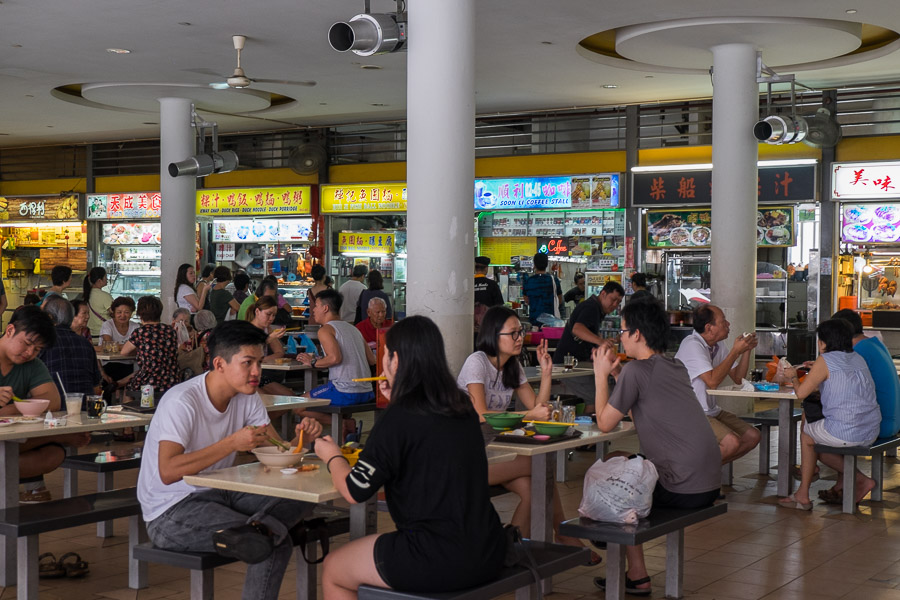
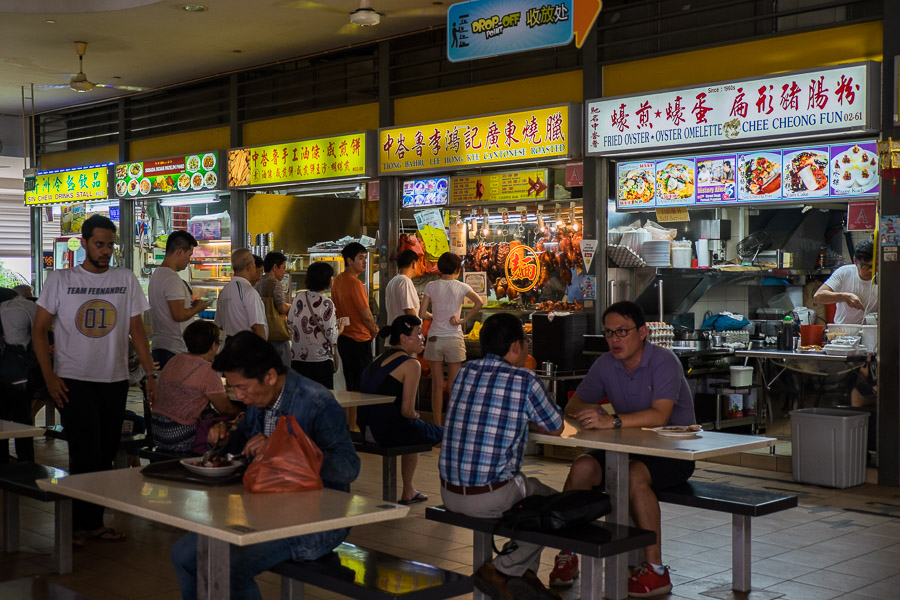
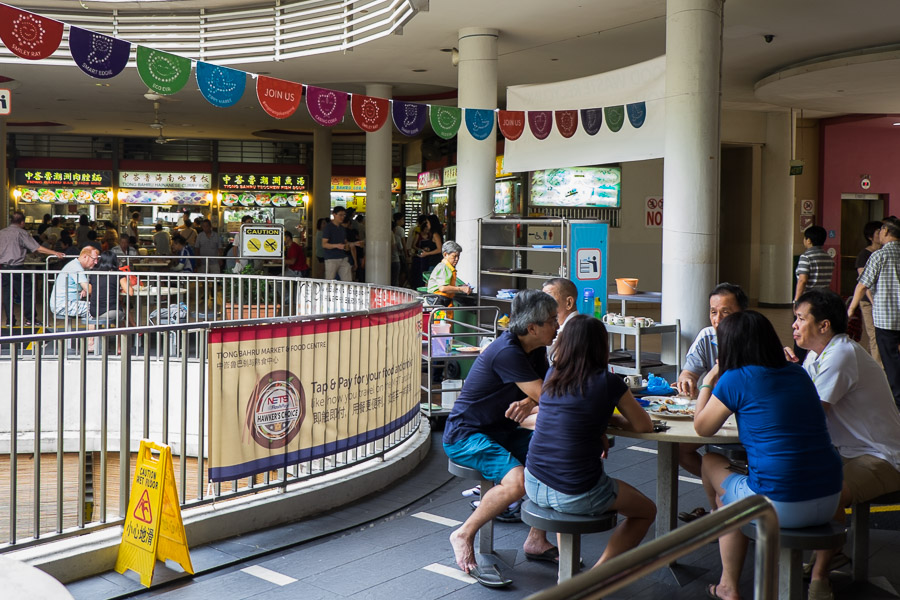
Tiong Bahru Market
30 Seng Poh Road, Singapore 168898
The nearest MRT stations are Tiong Bahru and Outram Park
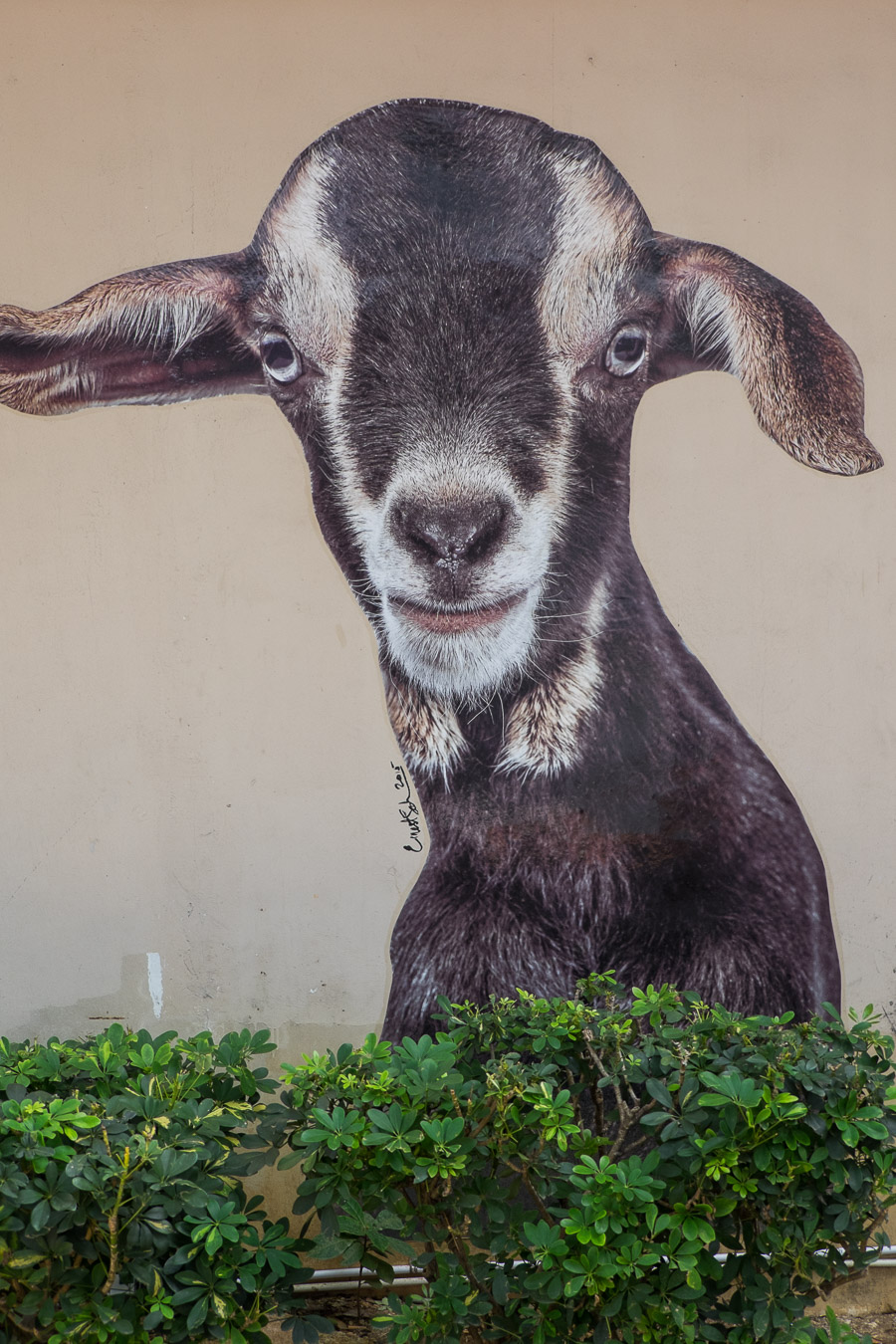 On a wall near the exit of the Tiong Bahru Market carpark, a goat mural painted by Ernest Goh around Tiong Bahru to celebrate the Year of the Goat (2015). There are goats painted in various locations around Tiong Bahru as part of a series called ‘Goat Xi Fa Cai’.
On a wall near the exit of the Tiong Bahru Market carpark, a goat mural painted by Ernest Goh around Tiong Bahru to celebrate the Year of the Goat (2015). There are goats painted in various locations around Tiong Bahru as part of a series called ‘Goat Xi Fa Cai’. Tiong Bahru was the first public housing estate built in Singapore, in the 1930s. The streets in Tiong Bahru are named after early Chinese Pioneers of Singapore. Seng Poh Road, for example, where Tiong Bahru Market is located is named after Tan Seng Poh, a local trader originally from Perak, Malaysia, who became a Justice of the Peace and Municipal Commissioner. If you like art deco-style architecture, it’s definitely worth taking a walk around Tiong Bahru.
Public housing in Singapore
About 80% of Singaporeans live in public housing apartments and of these, about 90% are owned by the occupier. The apartments are built by the Housing and Development Board and referred to ‘HDB flats’. Public housing towns (called ‘housing estates’ – Tiong Bahru is one) are located all across Singapore. The government provides financial planning assistance and various funding schemes to help more Singaporeans own their own home. Housing estates are not simply built and forgotten either; older estates are maintained, community facilities upgraded, and essential improvements to ageing homes are fully funded or largely subsidised by the government. Since the 1970s, a government policy has been in place to encourage multicultural communities and avoid ethnically segregated housing estates.
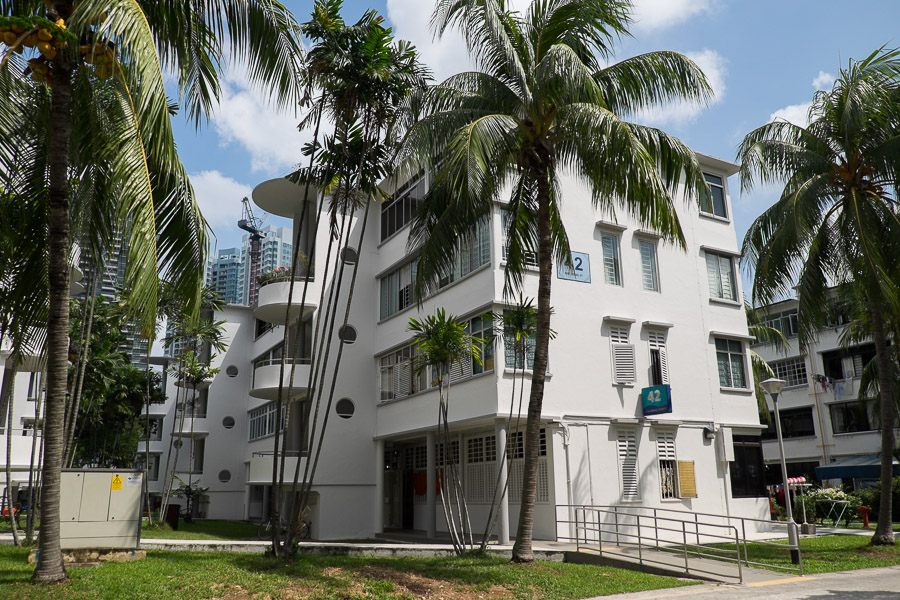 HDB flats in Tiong Bahru
HDB flats in Tiong Bahru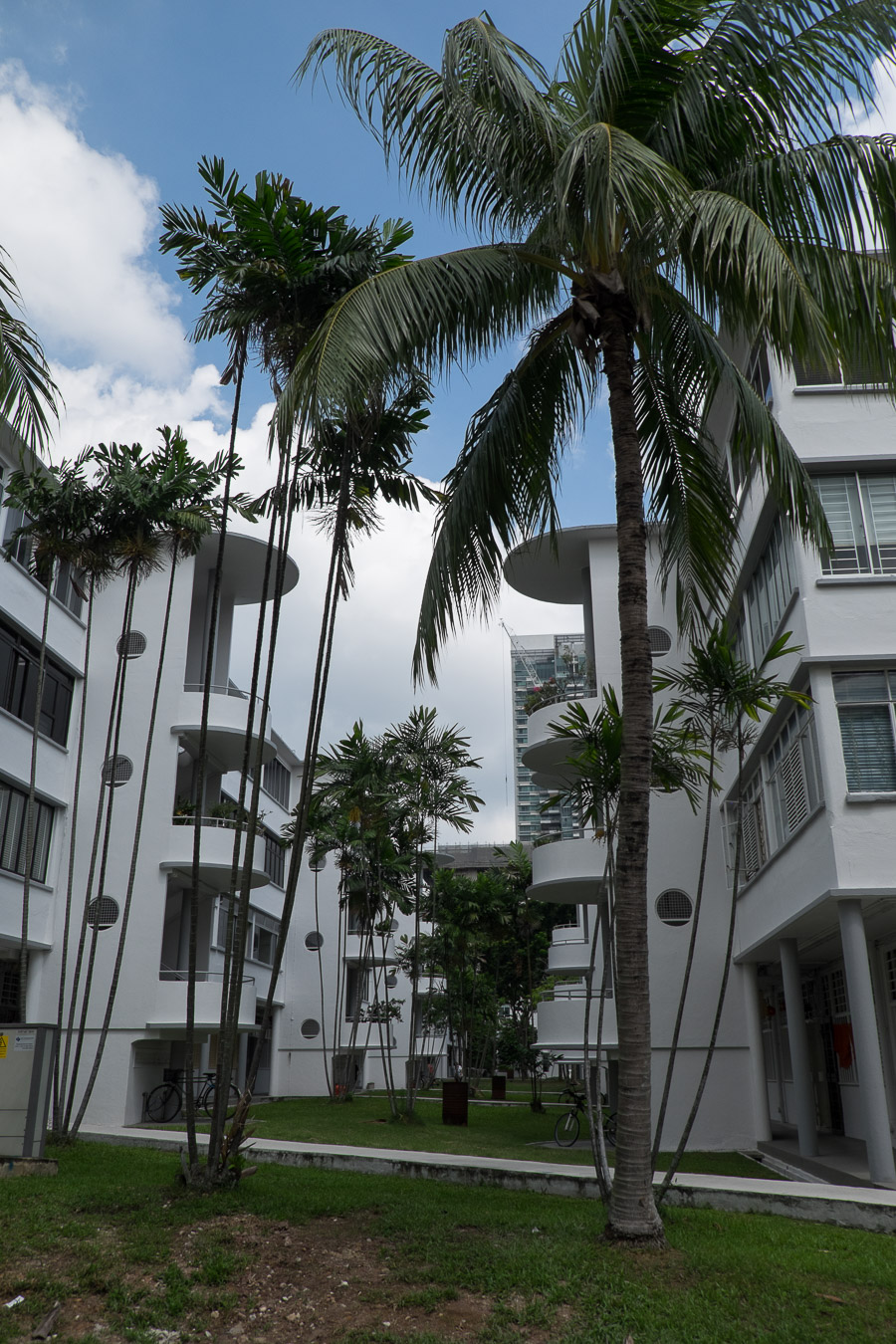
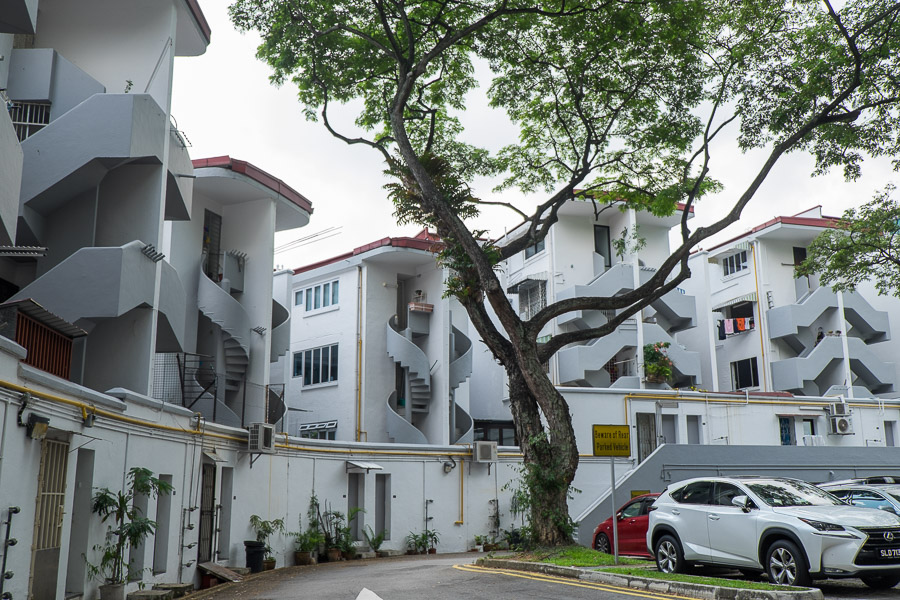 The spiral staircases are a cool feature of these apartments. One of the back doors in this car park is the entrance to a highly regarded Yakitori Bar called Bincho (on my list for my next trip!).
The spiral staircases are a cool feature of these apartments. One of the back doors in this car park is the entrance to a highly regarded Yakitori Bar called Bincho (on my list for my next trip!). 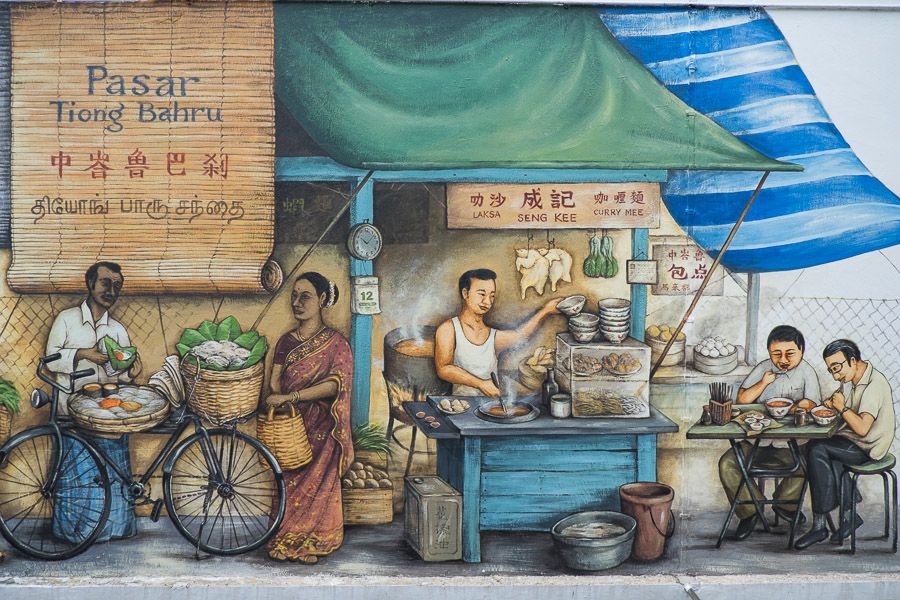 This is part of a mural called ‘Pasar and Fortune Teller’ by Yip Yew Chong (YC), located down an alley off Eng Watt Street in Tiong Bahru. Obviously the food-related content is very appealing to me, but I also love the mural’s fine details.
This is part of a mural called ‘Pasar and Fortune Teller’ by Yip Yew Chong (YC), located down an alley off Eng Watt Street in Tiong Bahru. Obviously the food-related content is very appealing to me, but I also love the mural’s fine details. 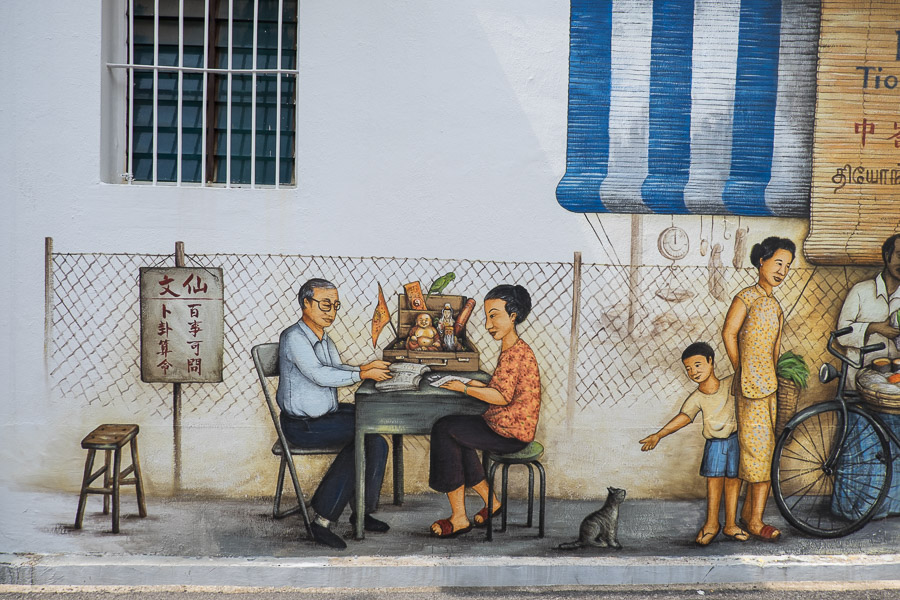 The ‘fortune teller’ part of the mural. Read more about the mural and its artist at his blog Walkabout with YC. The blog post includes a map showing the location of the artist’s murals in the Tiong Bahru area. Next time I visit Tiong Bahru I’m going to find the other murals by YC.
The ‘fortune teller’ part of the mural. Read more about the mural and its artist at his blog Walkabout with YC. The blog post includes a map showing the location of the artist’s murals in the Tiong Bahru area. Next time I visit Tiong Bahru I’m going to find the other murals by YC. Druggists
On our second afternoon in Singapore, we had drinks at a craft beer bar called Druggists, named after the Singapore Druggists Association which it shares an 80-year old shophouse with. Inside, this trendy bar has the look of an old-fashioned kopitiam, with wooden coffee shop stools and shiny marble-topped tables on the original retro tiled floor.
Druggists
119 Tyrwhitt Road (just off Jalan Besar), Singapore 207547
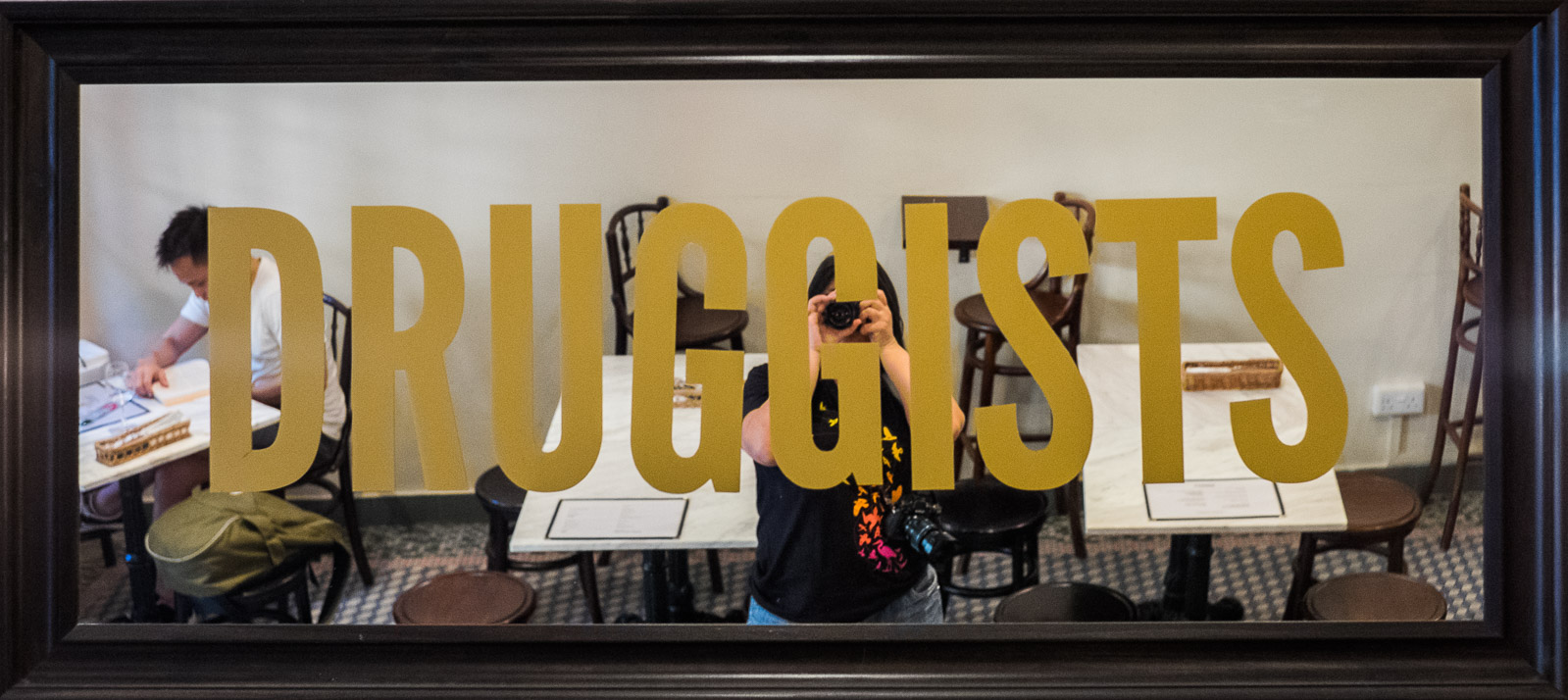
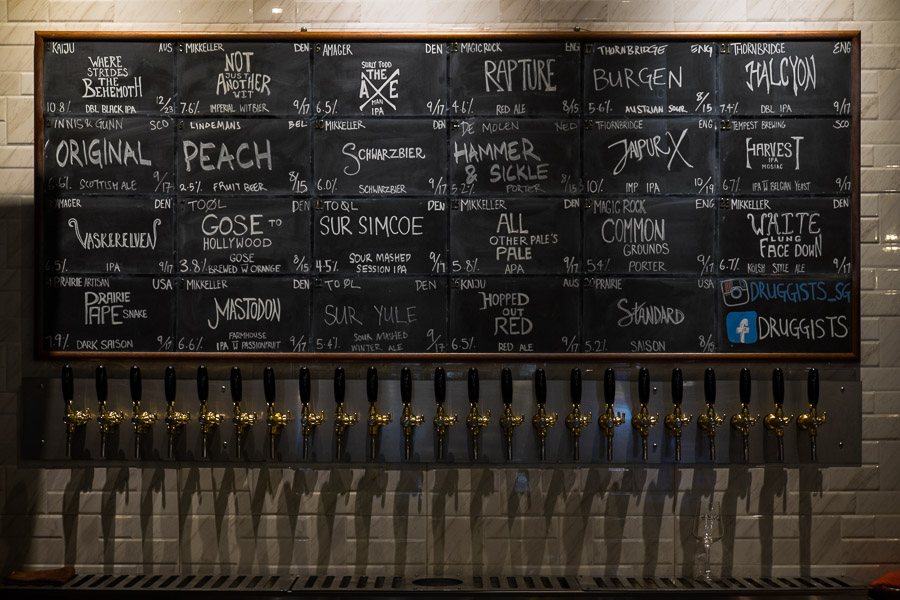 The Druggists bar boasts 23 craft beer taps, ranging from stouts to more easy-drinking lagers. The selection changes regularly. If you feel you might need help choosing, don’t be afraid to tell the guys behind the bar what your beer preferences are (so they can make some recommendations). You can even ask for a taster/sample.
The Druggists bar boasts 23 craft beer taps, ranging from stouts to more easy-drinking lagers. The selection changes regularly. If you feel you might need help choosing, don’t be afraid to tell the guys behind the bar what your beer preferences are (so they can make some recommendations). You can even ask for a taster/sample. 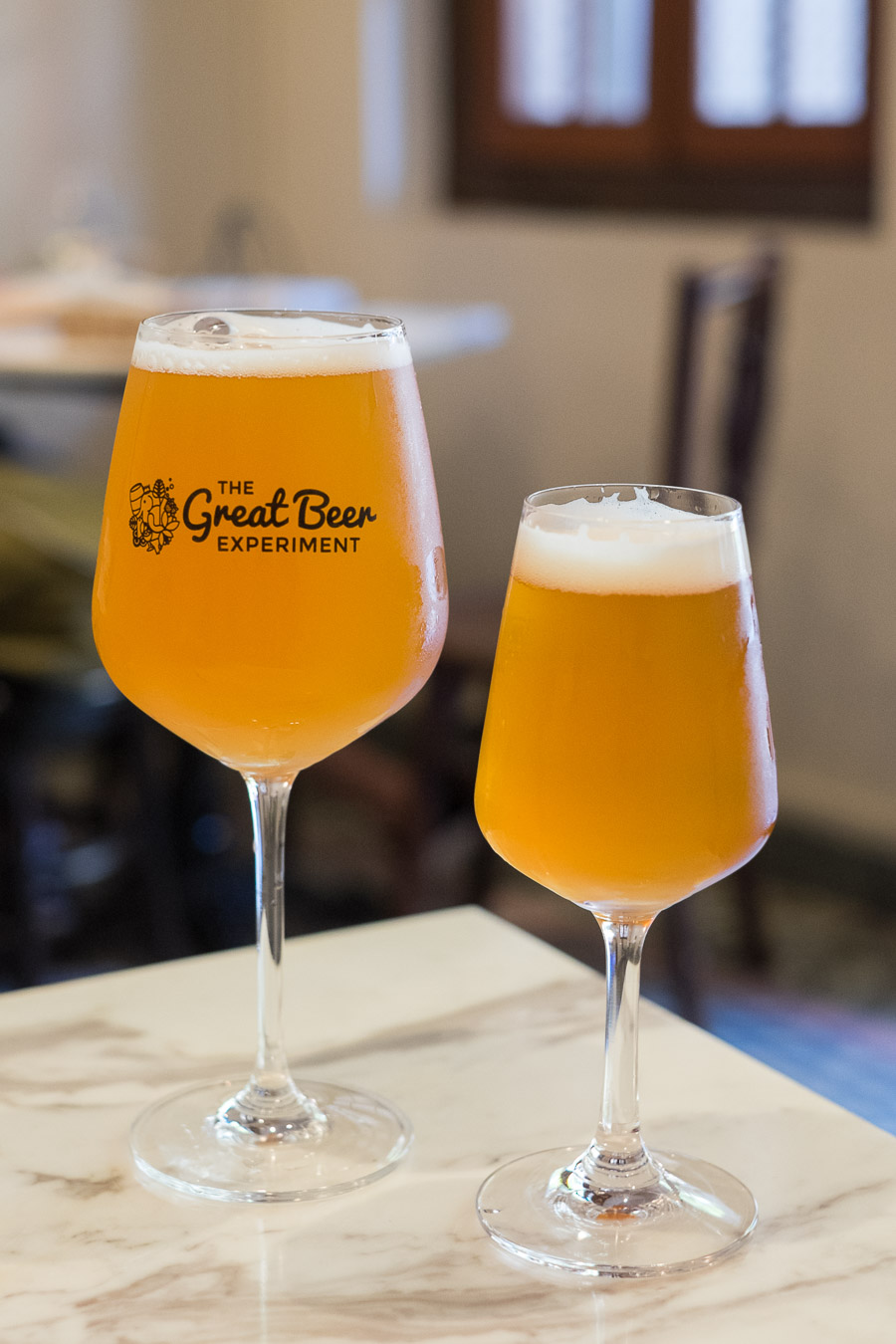 I had a half-pint of Gose to Hollywood, brewed with orange – a light, gently sour beer, more reminiscent of lemon than orange.
I had a half-pint of Gose to Hollywood, brewed with orange – a light, gently sour beer, more reminiscent of lemon than orange. 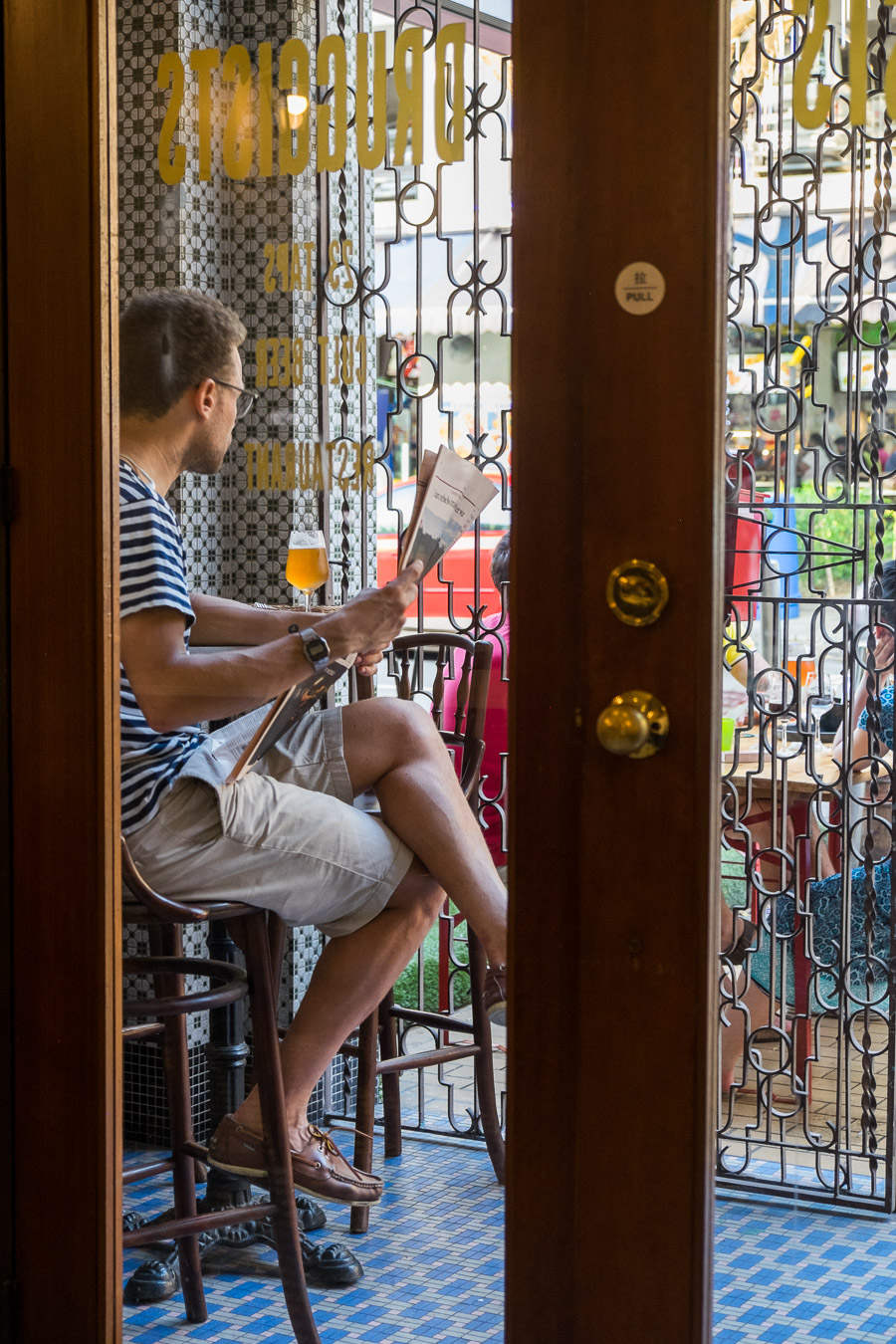 It’s air-conditioned inside, and so with a cold beer and bar snacks (think sambal chicken wings, fries slathered in chilli crab sauce or salted egg sauce, king oyster mushroom chips, marmite cheese sticks and satay sliders), it’s a place to escape the heat and humidity – if you prefer, you can watch the world go by from the outside tables.
It’s air-conditioned inside, and so with a cold beer and bar snacks (think sambal chicken wings, fries slathered in chilli crab sauce or salted egg sauce, king oyster mushroom chips, marmite cheese sticks and satay sliders), it’s a place to escape the heat and humidity – if you prefer, you can watch the world go by from the outside tables. Ya Kun
We had breakfast one morning at Ya Kun Kaya Toast, which began in 1944 as a humble coffee stall, is now franchised all over Singapore and has expanded throughout Asia with outlets in China, Hong Kong, Indonesia, Myanmar, South Korea, Taiwan, Thailand and the Philippines. Ya Kun is due to open next in Cambodia and Japan. I wish it would come to Perth.
Ya Kun’s signature offering is the classic Singaporean kopitiam breakfast of kaya toast (toast with butter and kaya, a coconut jam) and soft boiled eggs, to which you add a dash of soy sauce and sprinkle of white pepper (always white pepper). Some people prefer to eat the eggs first, then the toast; others (including me) like to dip the toast into the eggs. To the uninitiated, it may sound a strange and possibly unappealing combo of sweet and savoury flavours – but I love it.
- All over Singapore
- We went to Ya Kun at 313 Orchard Road, a short stroll from the hotel
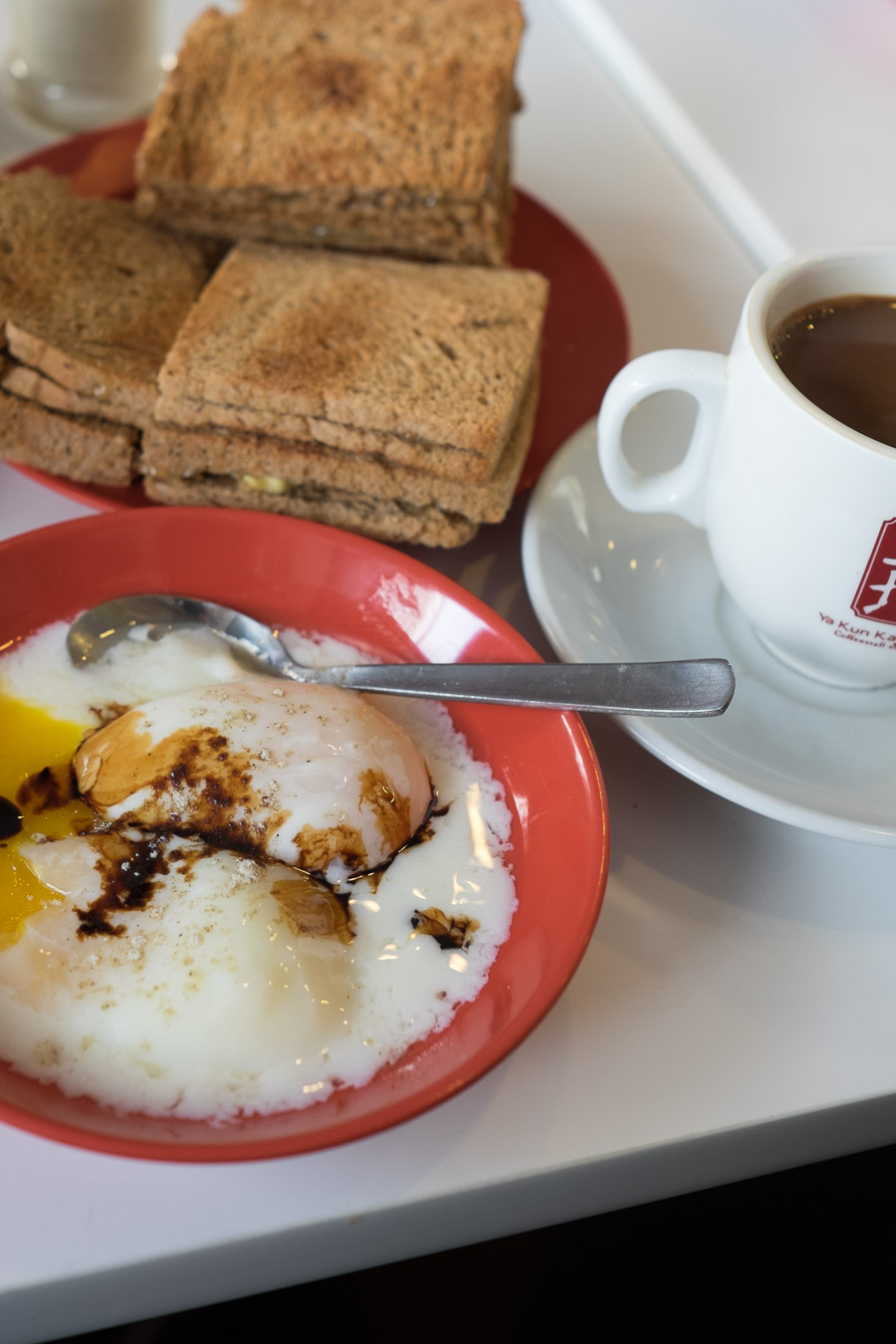 Kaya toast, soft boiled eggs and kopi (coffee) ‘c’. Ya Kun’s brown toast is sliced thinner than I usually like for toast; it’s always crisp but not hard. The butter is sliced rather than spread on and can look disconcertingly like cheese (!) but it all works. I love soft-boiled eggs, so this is my idea of heaven.
Kaya toast, soft boiled eggs and kopi (coffee) ‘c’. Ya Kun’s brown toast is sliced thinner than I usually like for toast; it’s always crisp but not hard. The butter is sliced rather than spread on and can look disconcertingly like cheese (!) but it all works. I love soft-boiled eggs, so this is my idea of heaven. Ordering coffee and tea in a Singaporean kopitiam (coffee shop)
When in Singapore, ordering coffee (kopi) or tea (teh) is easy if you know the lingo. A similar vocabulary is used in Malaysia.
It helps if you know what the component terms mean:
- kopi is coffee
- teh is tea
- ‘o’ or oh means without milk
- kosong is Malay for ‘zero’. In this context, it means without sugar (unsweetened)
- beng (sometimes peng) is iced
- ‘c’ means with evaporated milk. Some say this originates from the Hainanese ‘xi’ (meaning ‘fresh’), which sounds like ‘c’. Others say the ‘c’ refers to ‘Carnation’, the ubiquitous brand of evaporated milk used to make these drinks.
So using the component terms, some of the common drinks are below. It’s important to note drinks are usually served sweetened unless ordered as ‘kosong’. I like kopi c, teh c and cham.
- kopi oh – hot black coffee, sweetened
- kopi oh kosong – hot black coffee, unsweetened
- kopi c – hot coffee with evaporated milk, sweetened
- teh oh – hot tea, no milk, sweetened
- tea oh kosong – hot tea, no milk, unsweetened
- teh c – hot tea with evaporated milk, sweetened
- teh c beng – iced tea with evaporated milk, sweetened
- cham – mixture of coffee and tea, made with milk and sweetened
- cham beng – iced cham
My Singapore 2016 series
I was in Singapore from 15 to 19 July as a guest of the Singapore Tourism Board. My flights, accommodation, and the activities/meals described in this post were all courtesy of Singapore Tourism Board. All opinions are my own.
